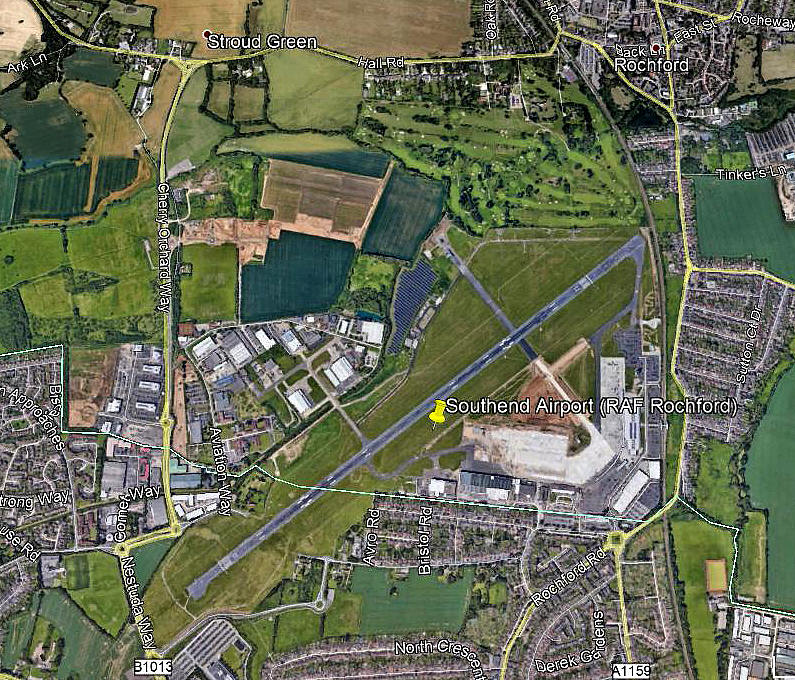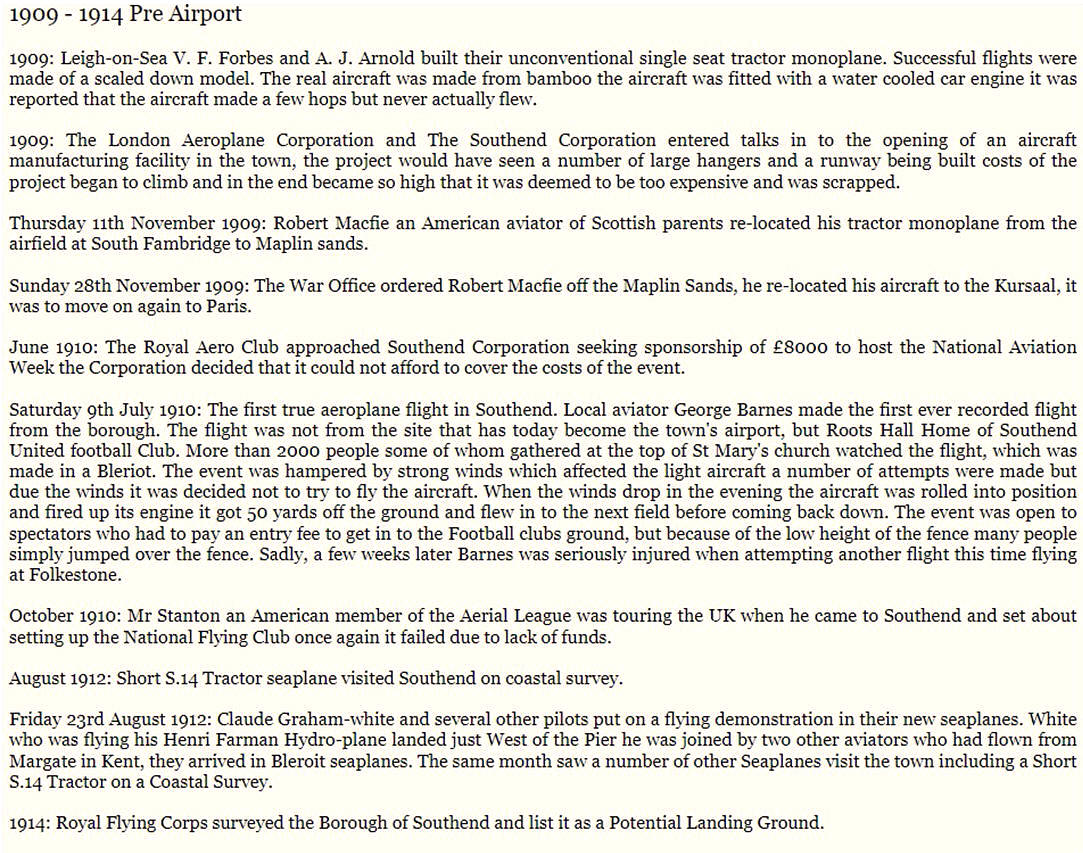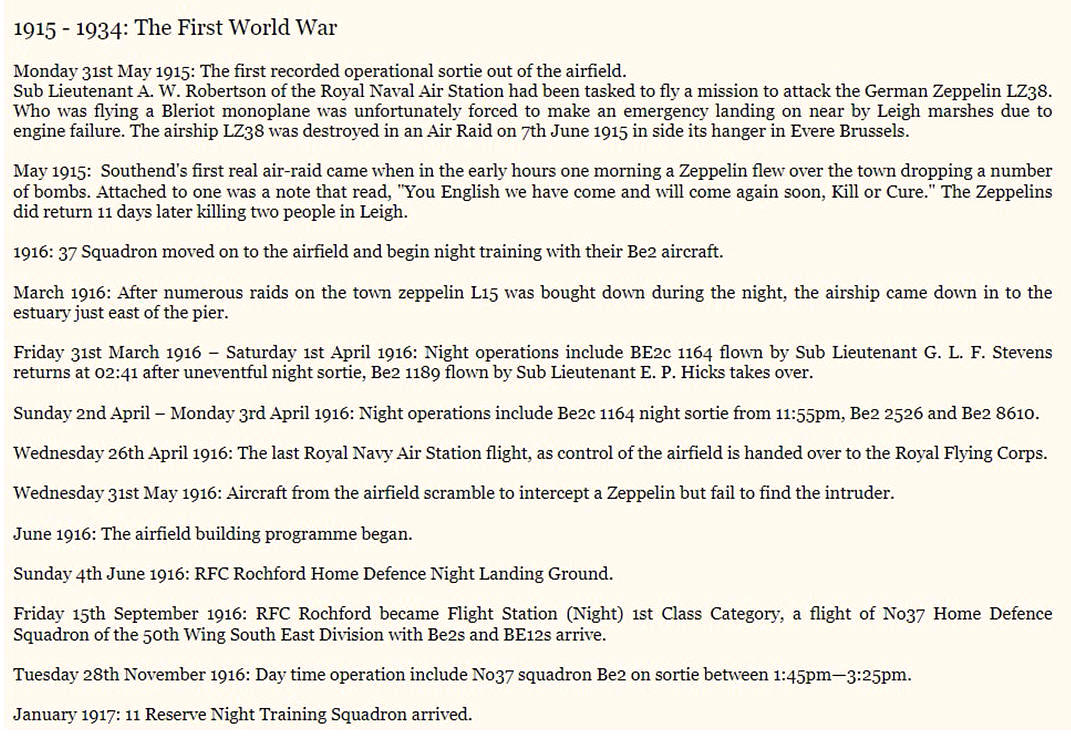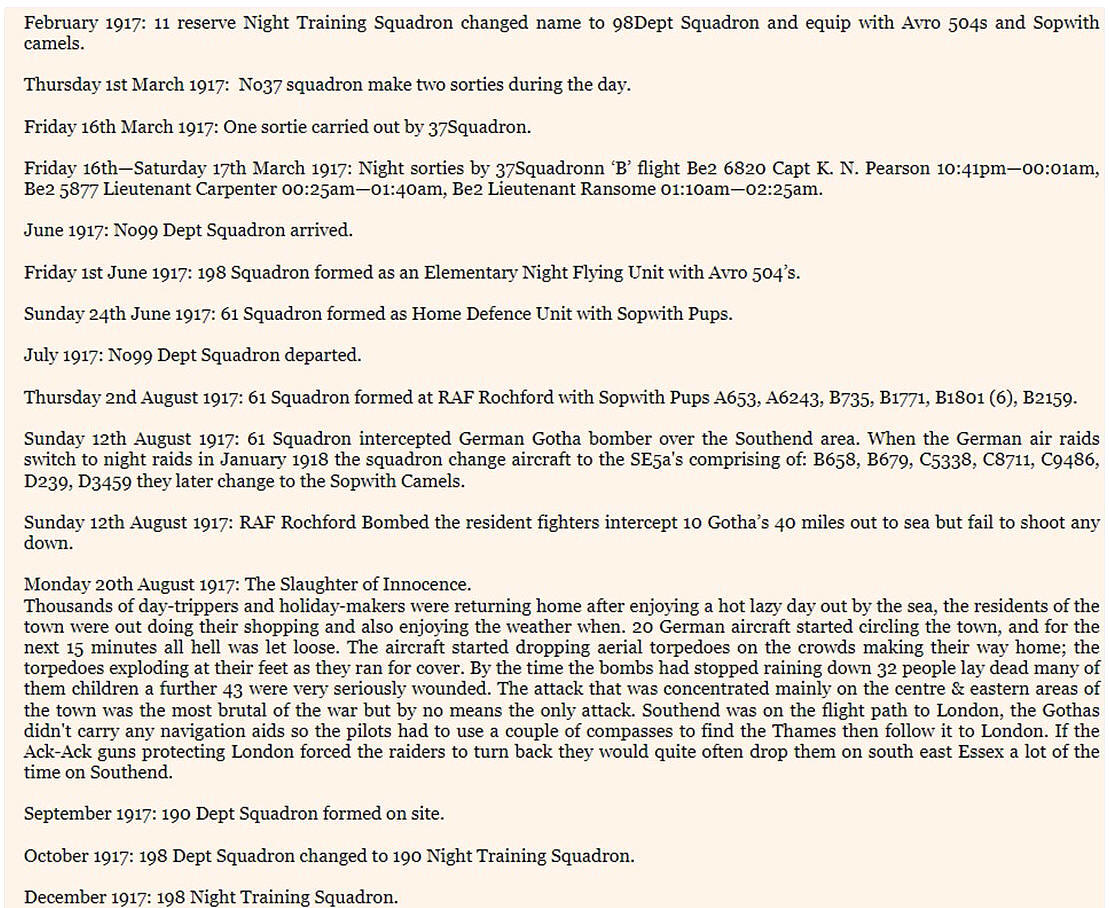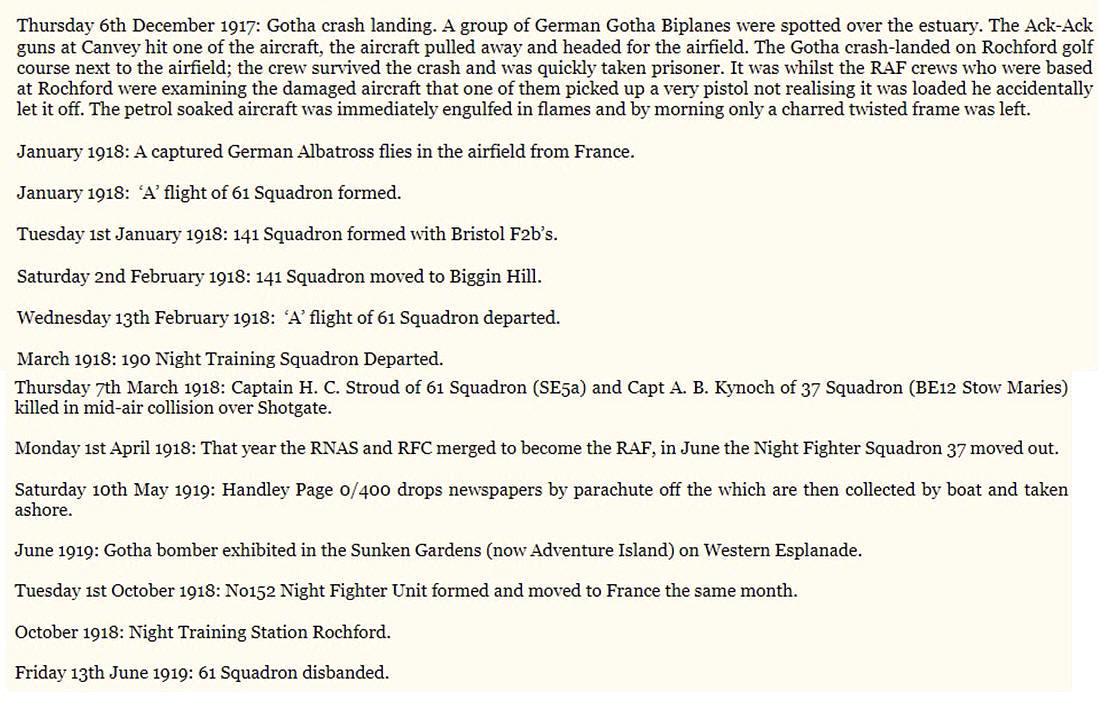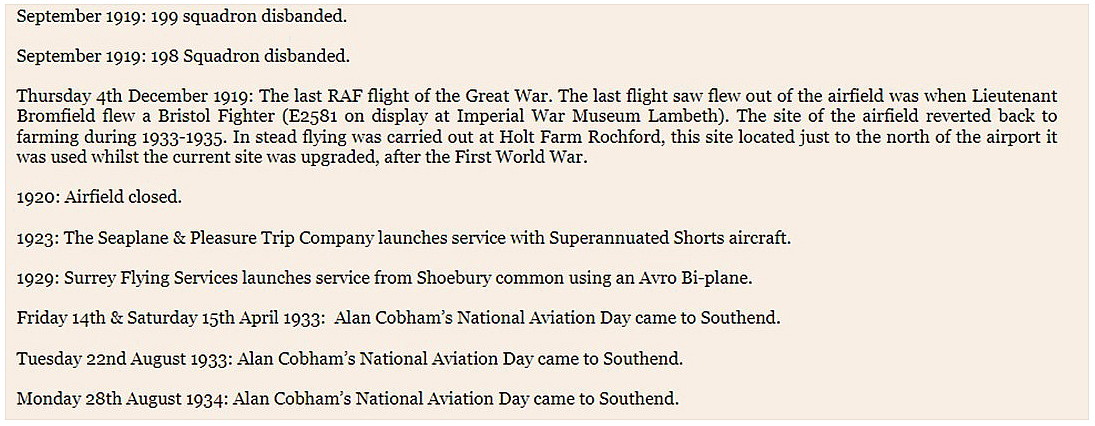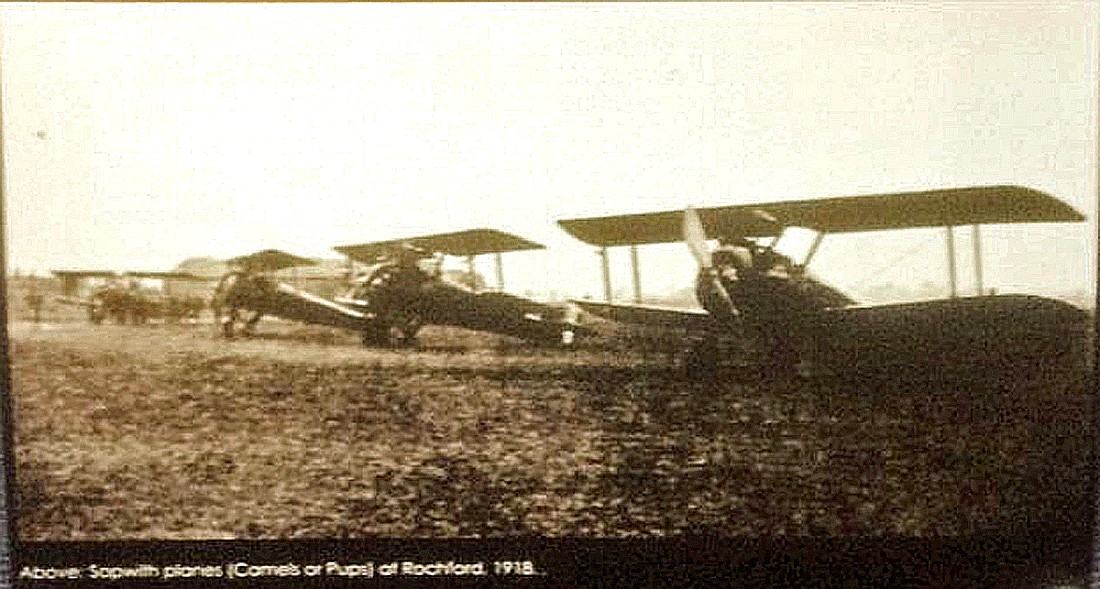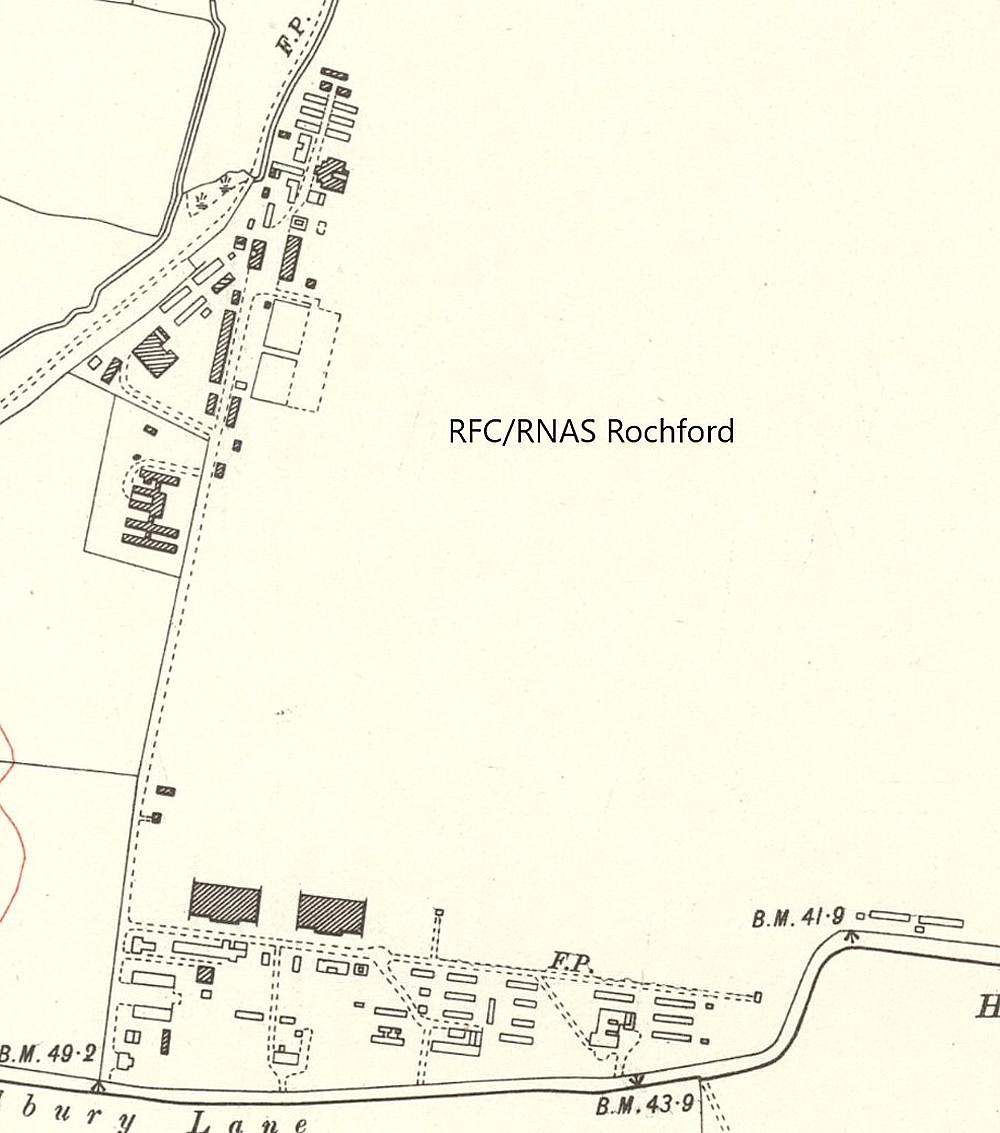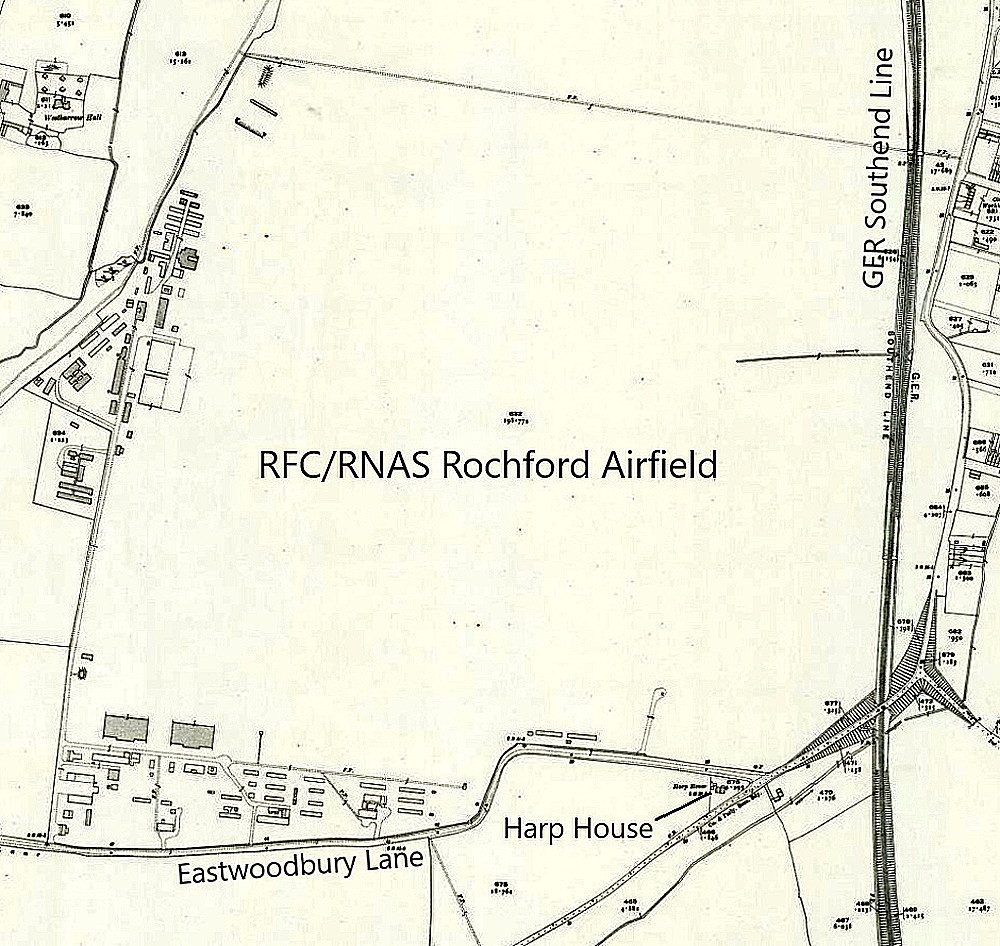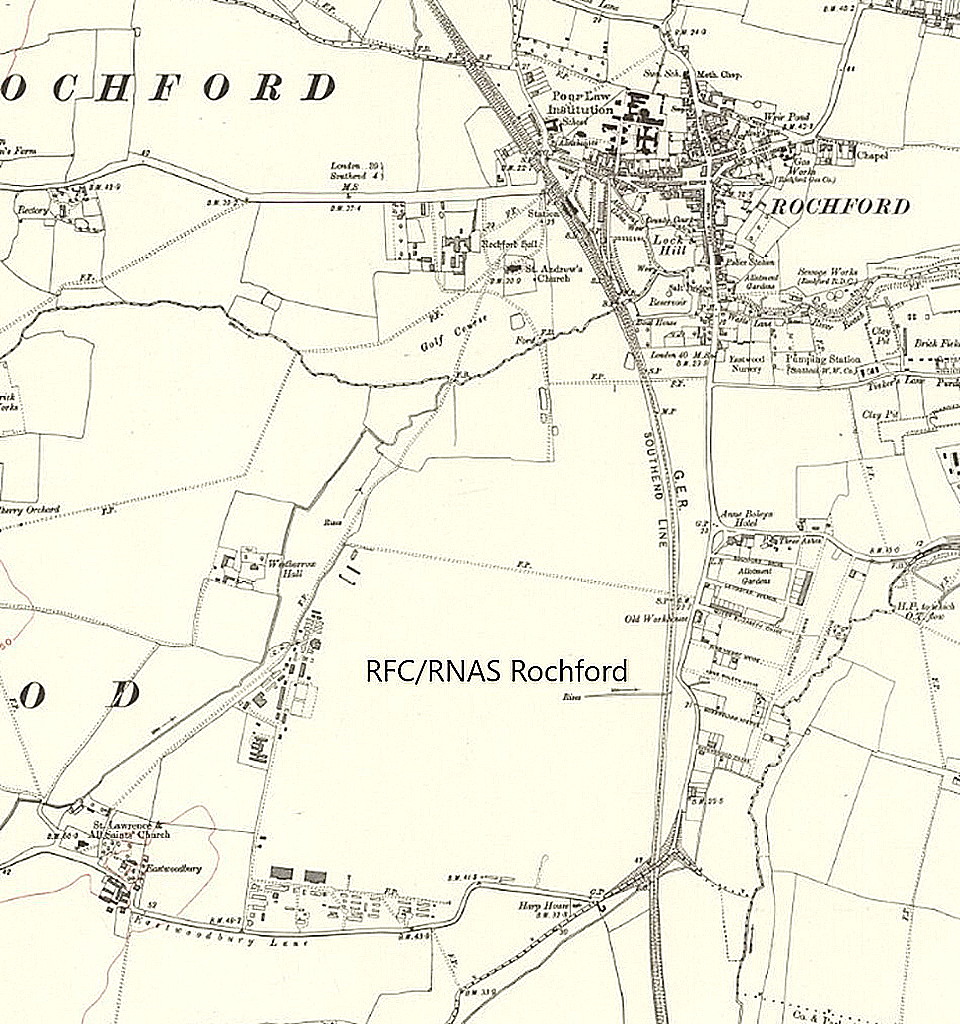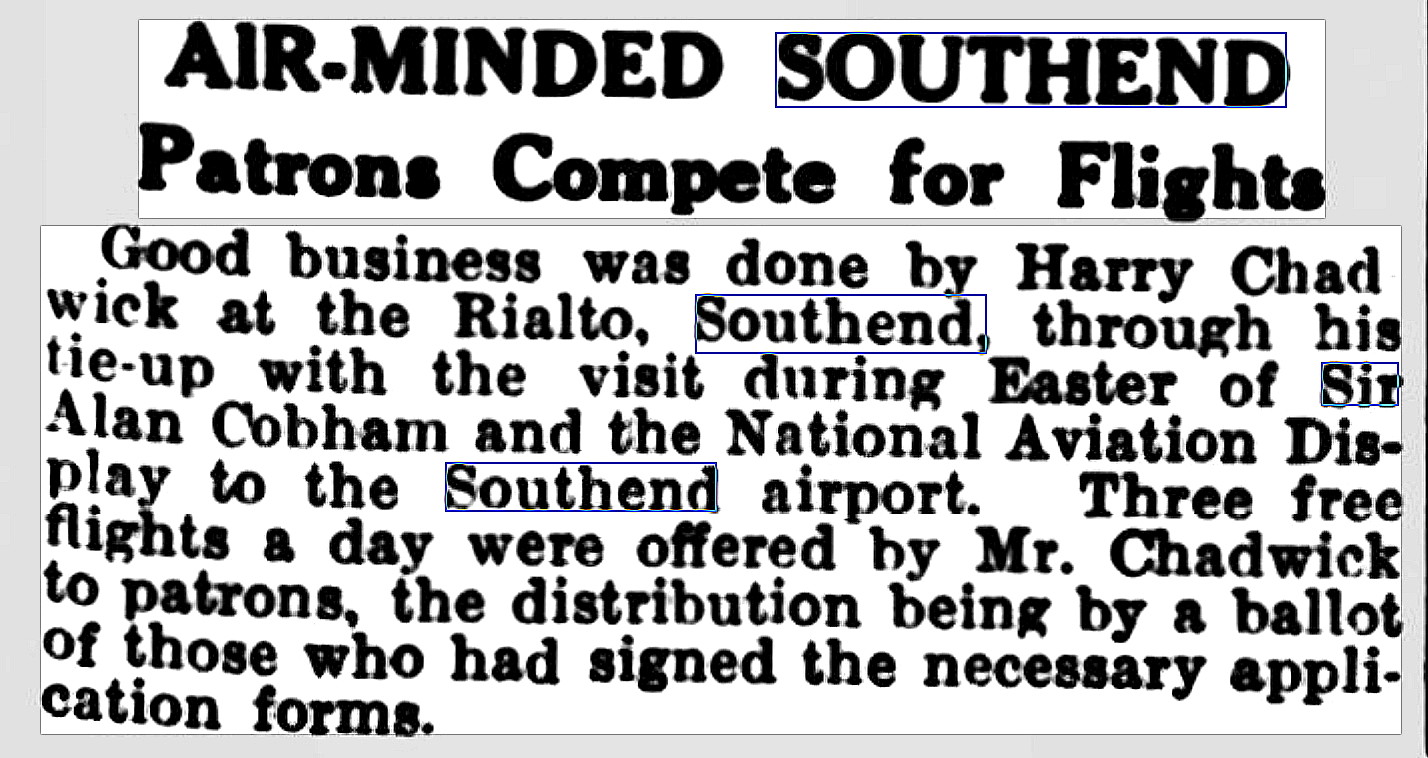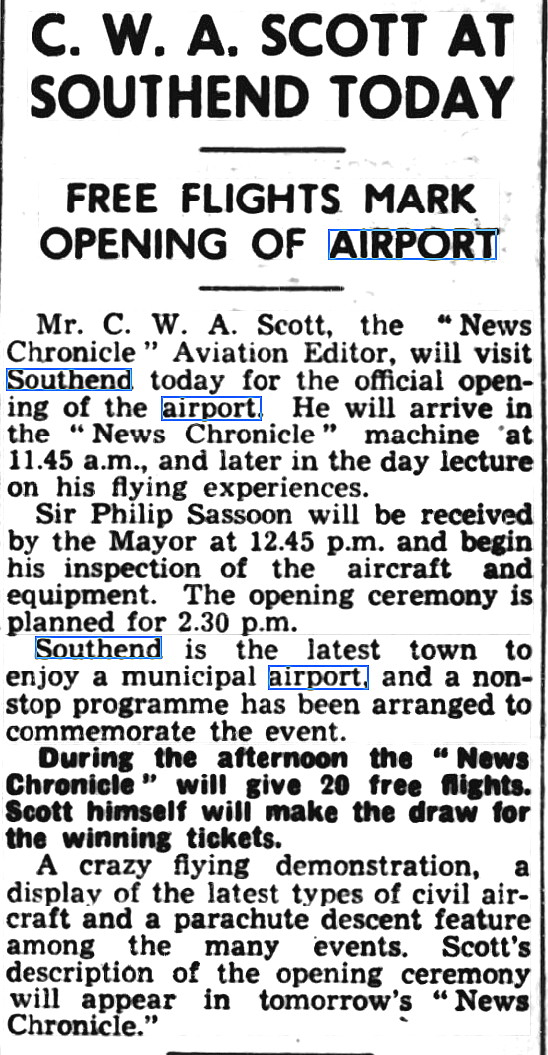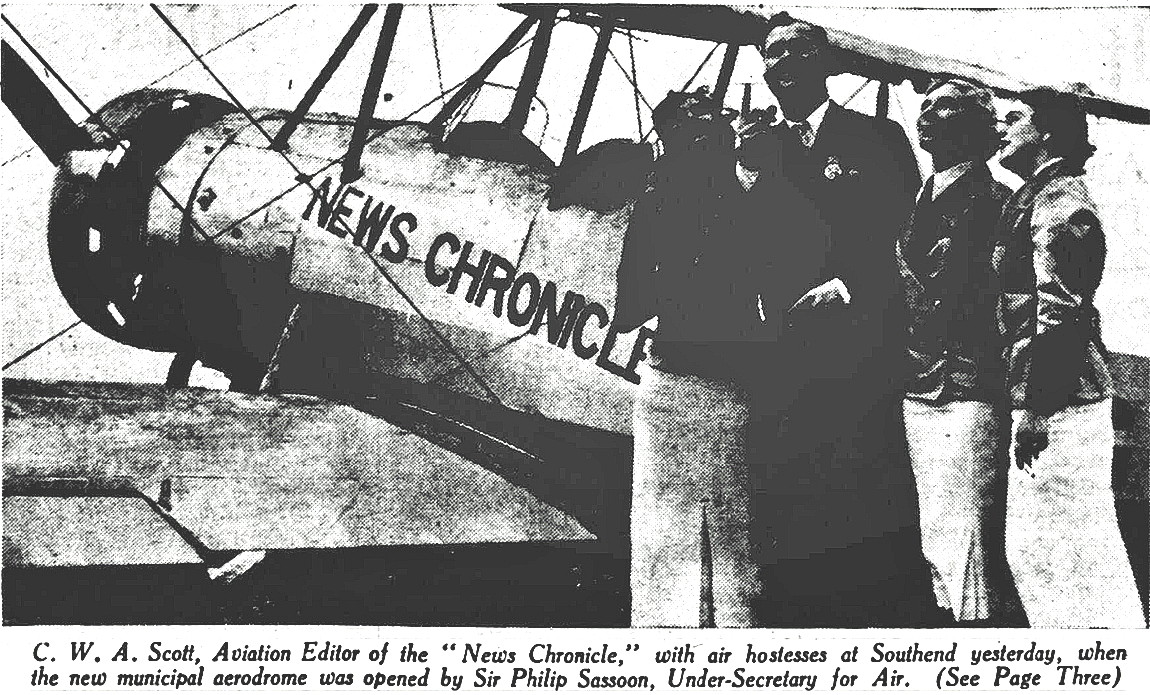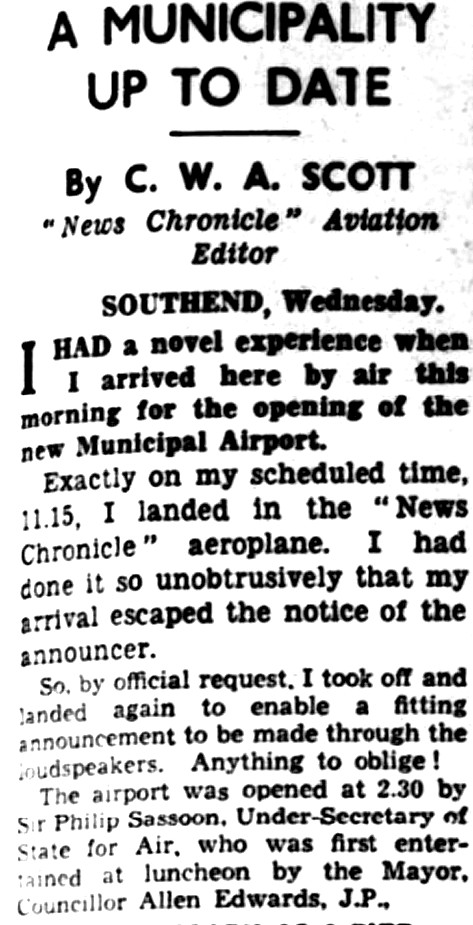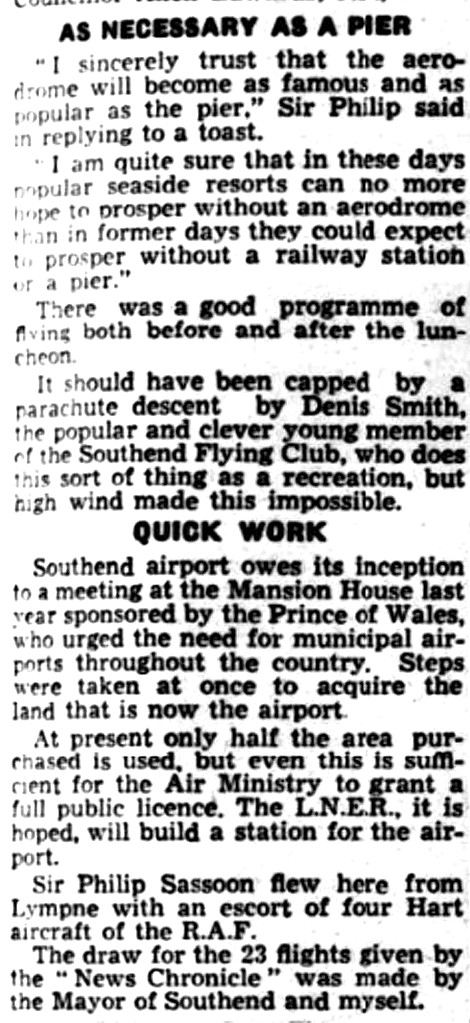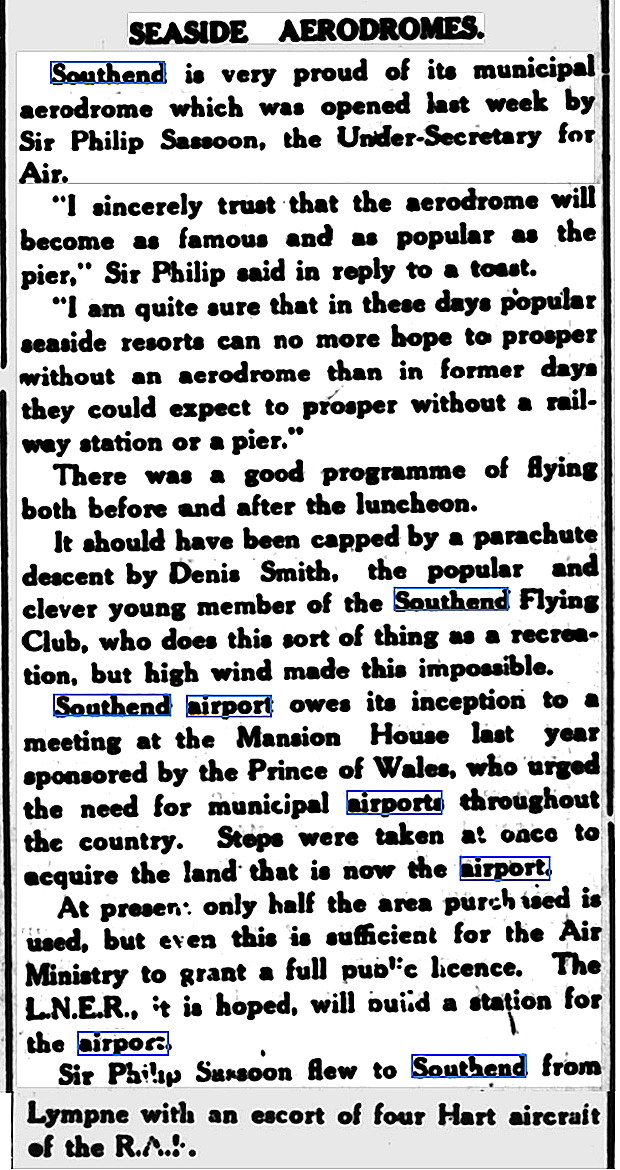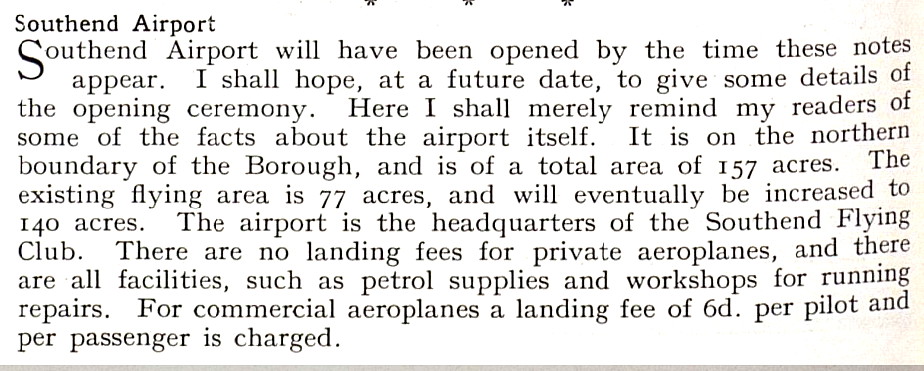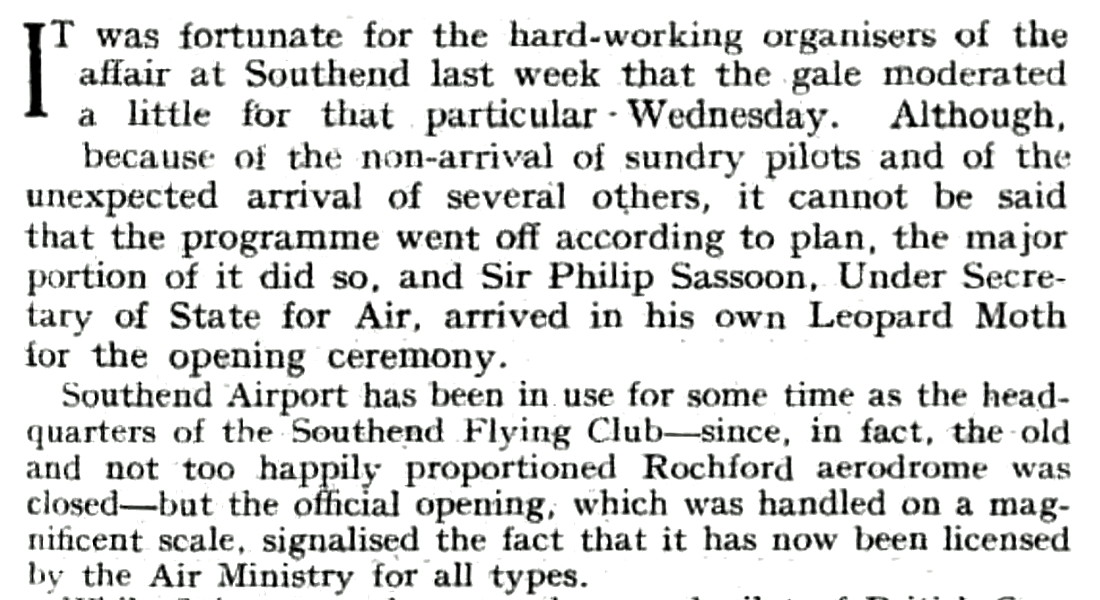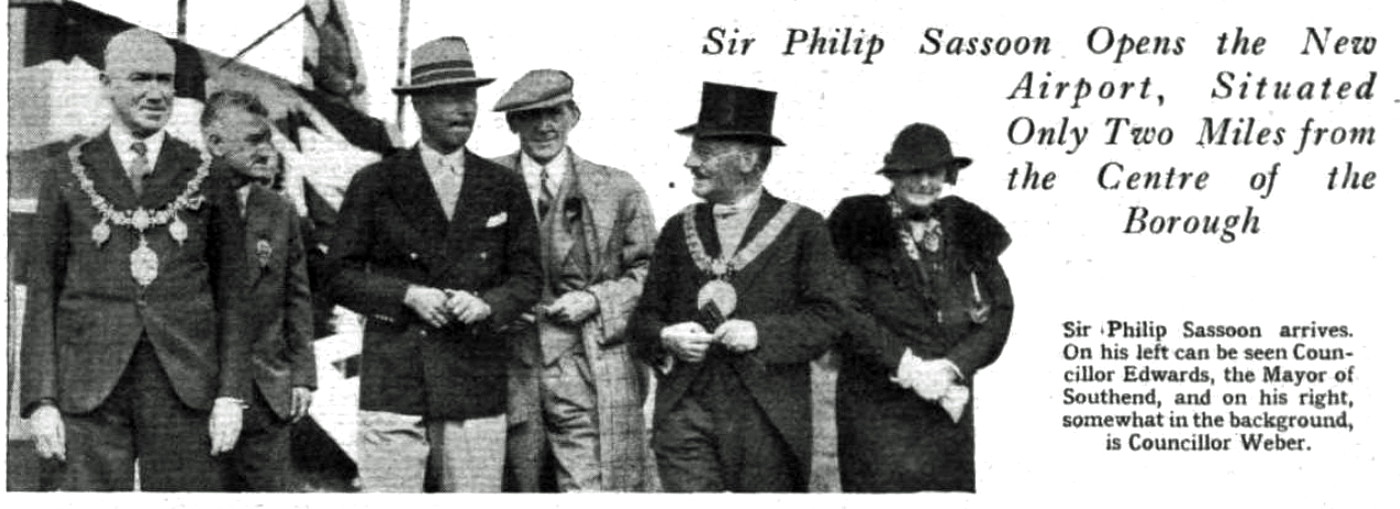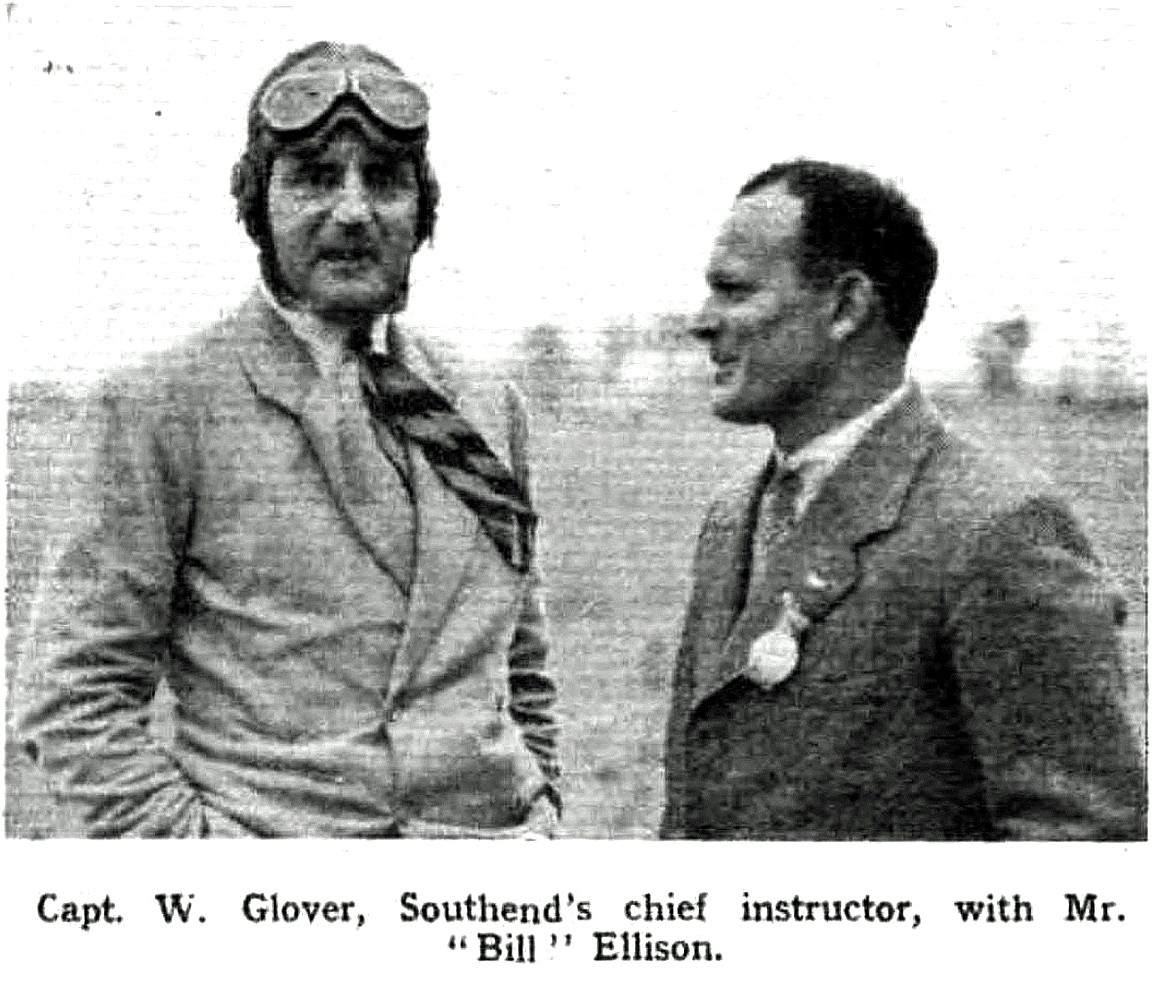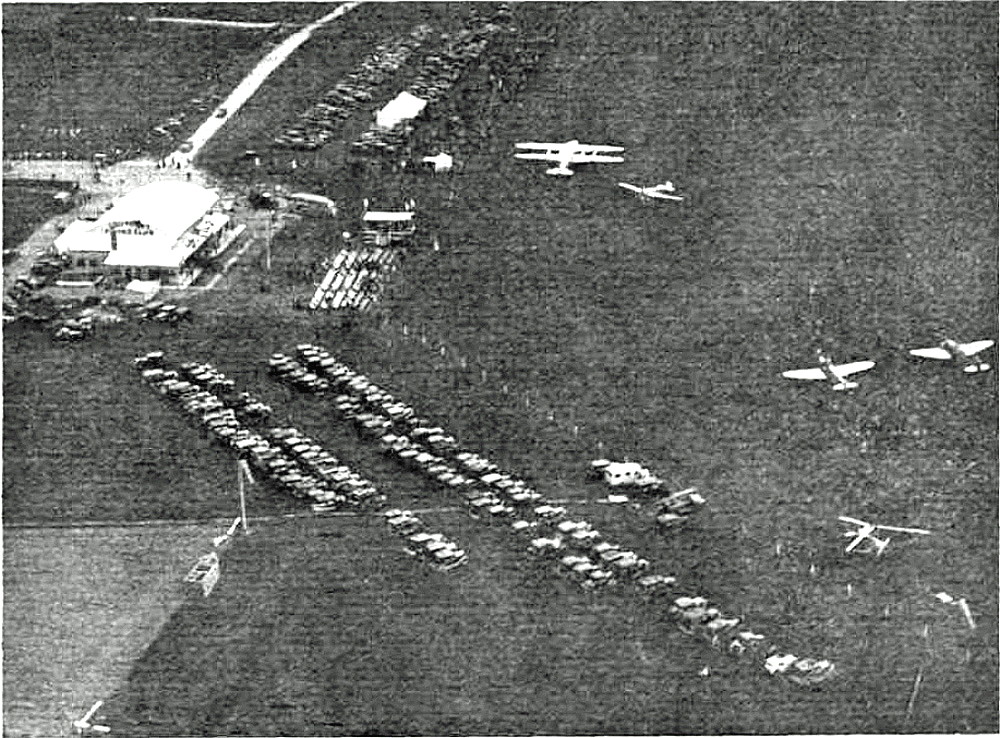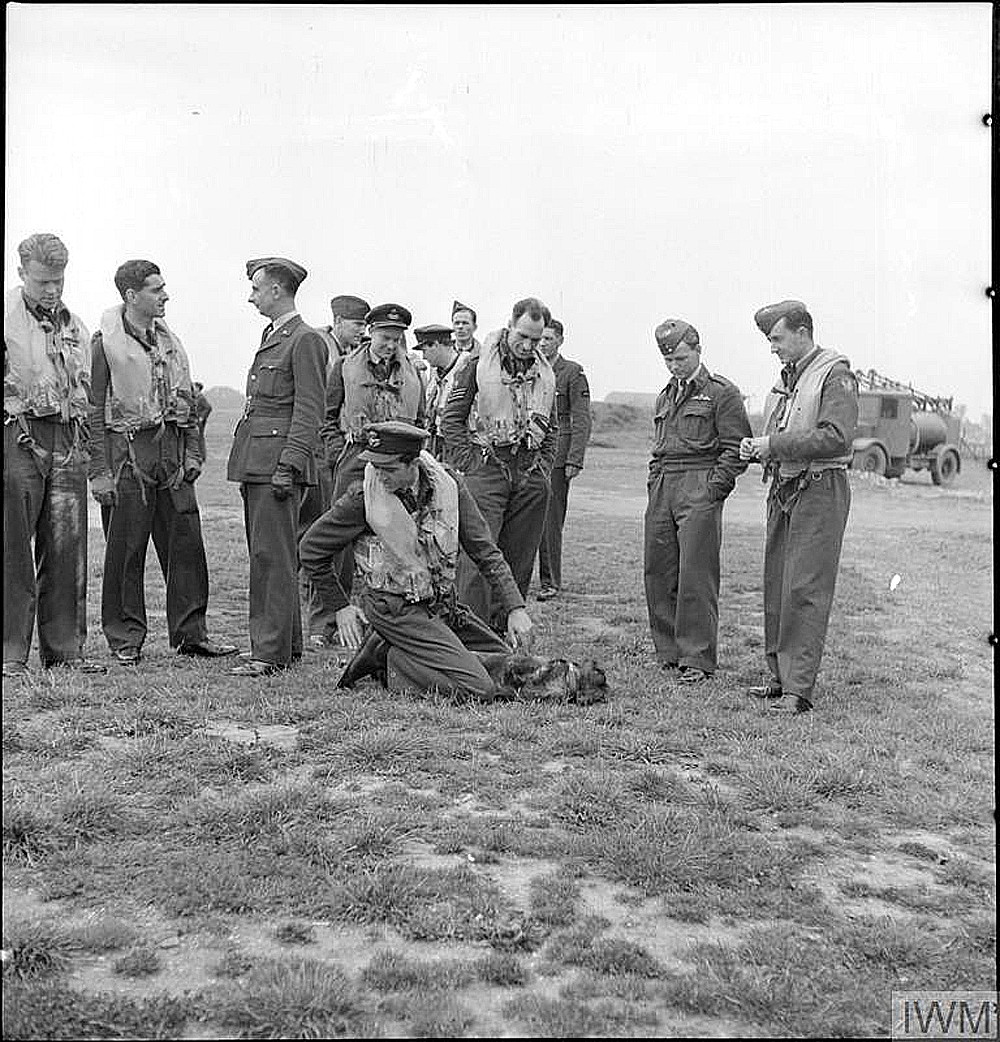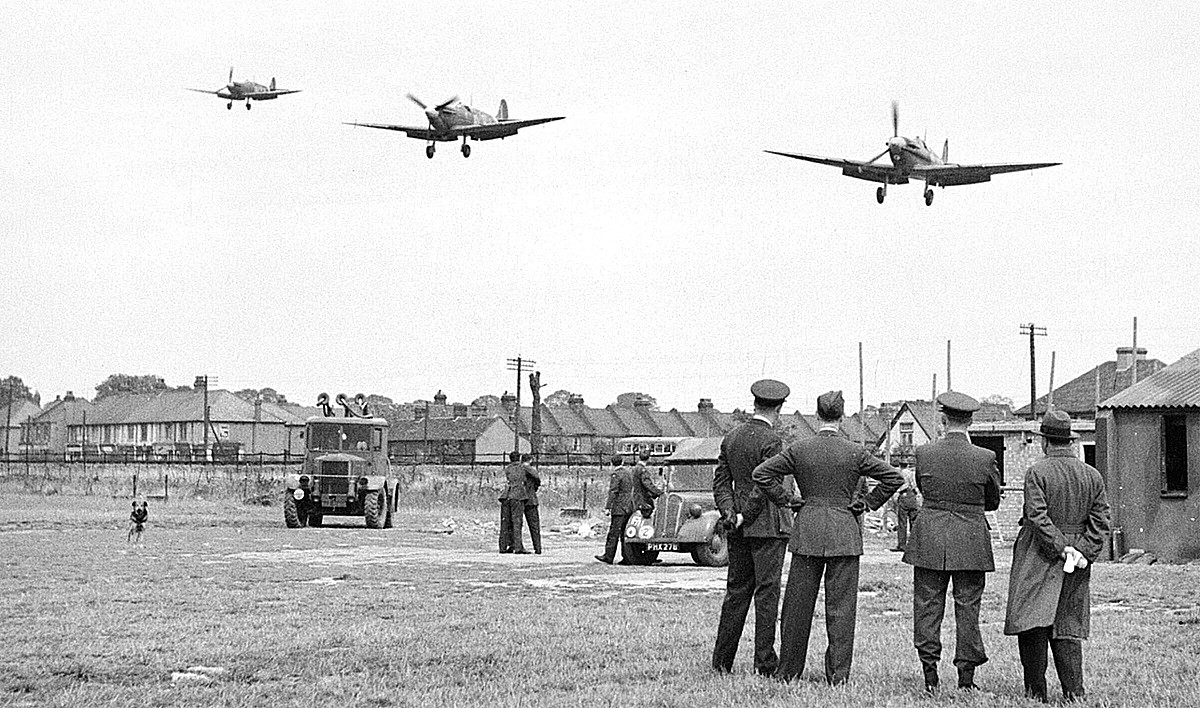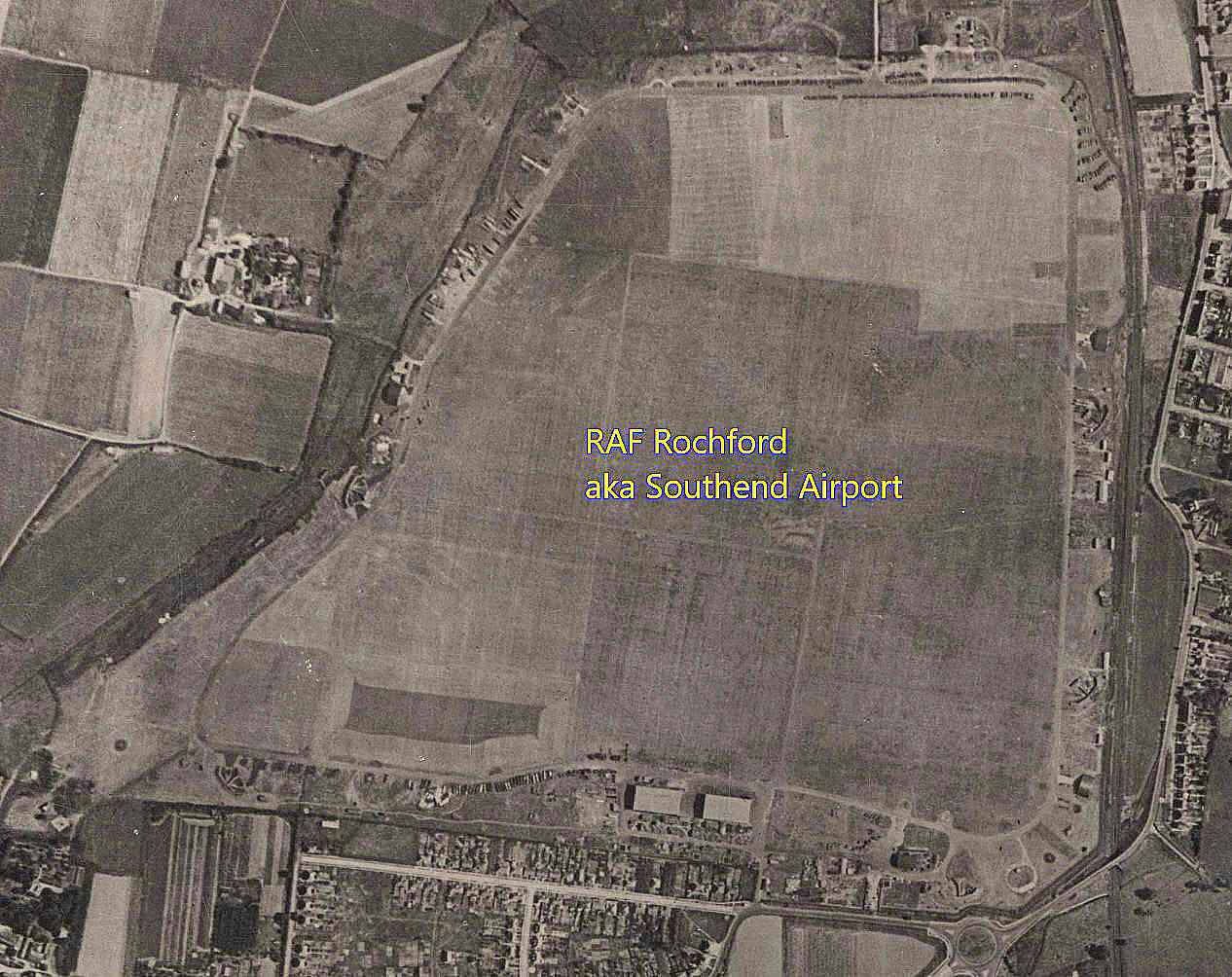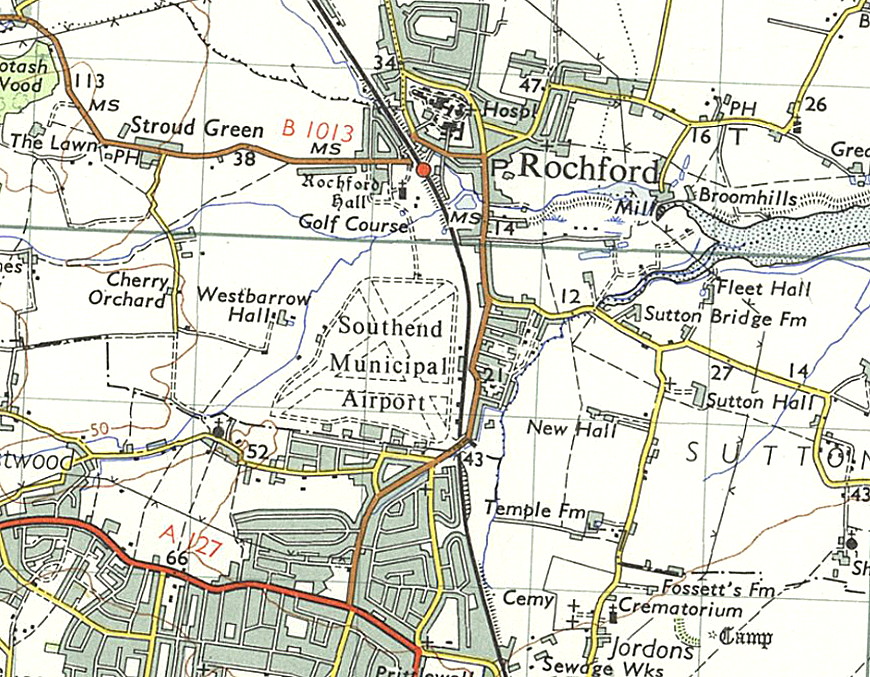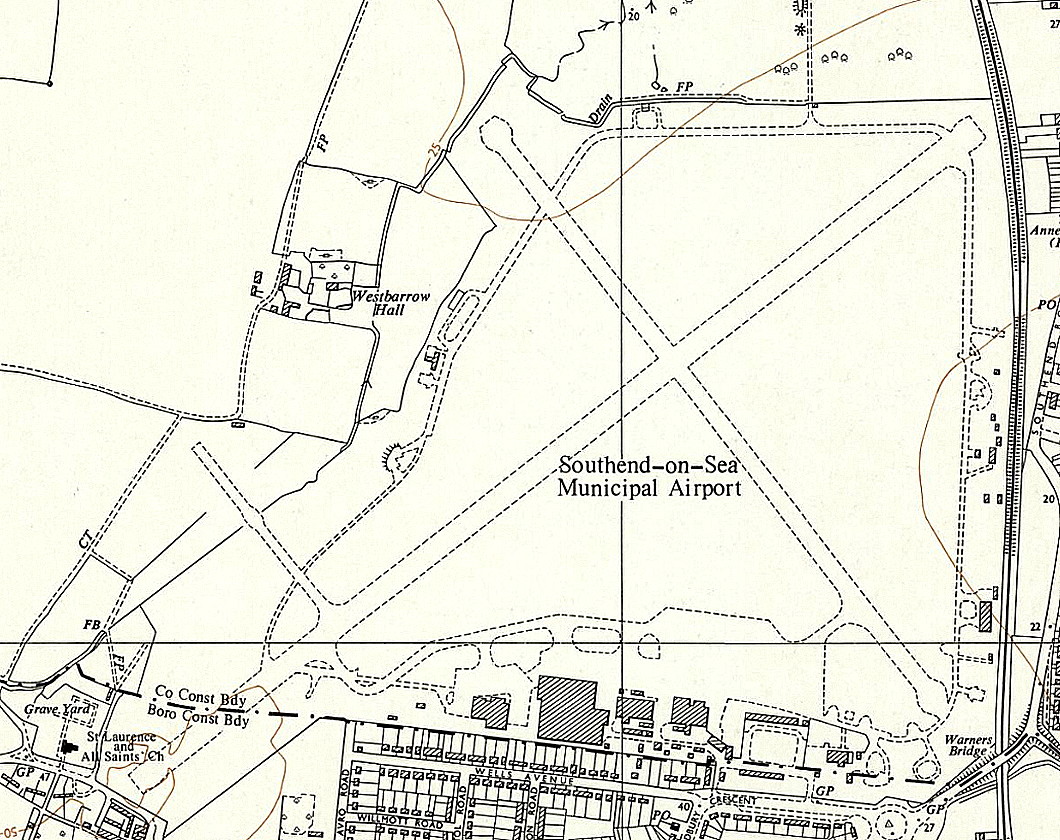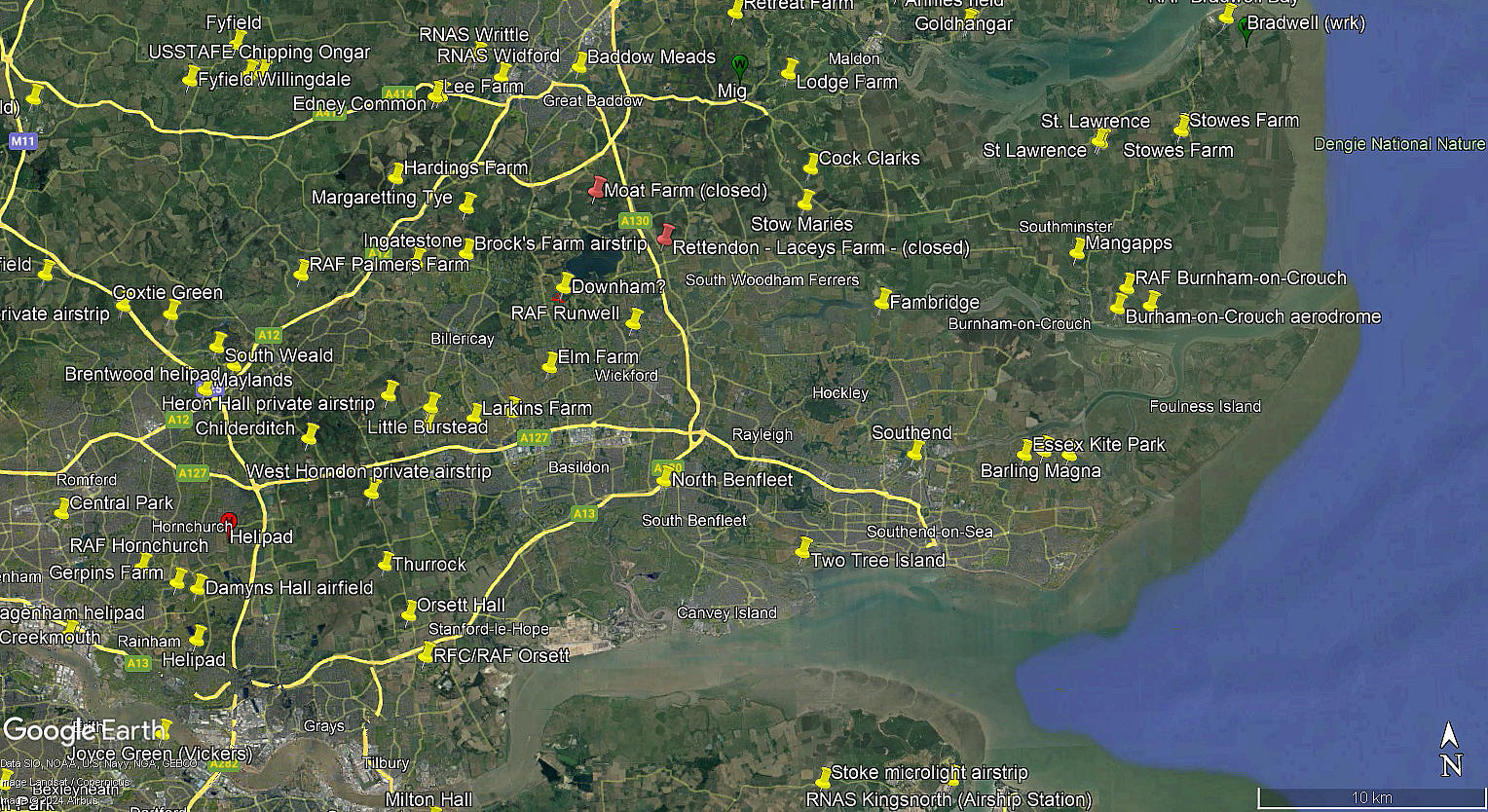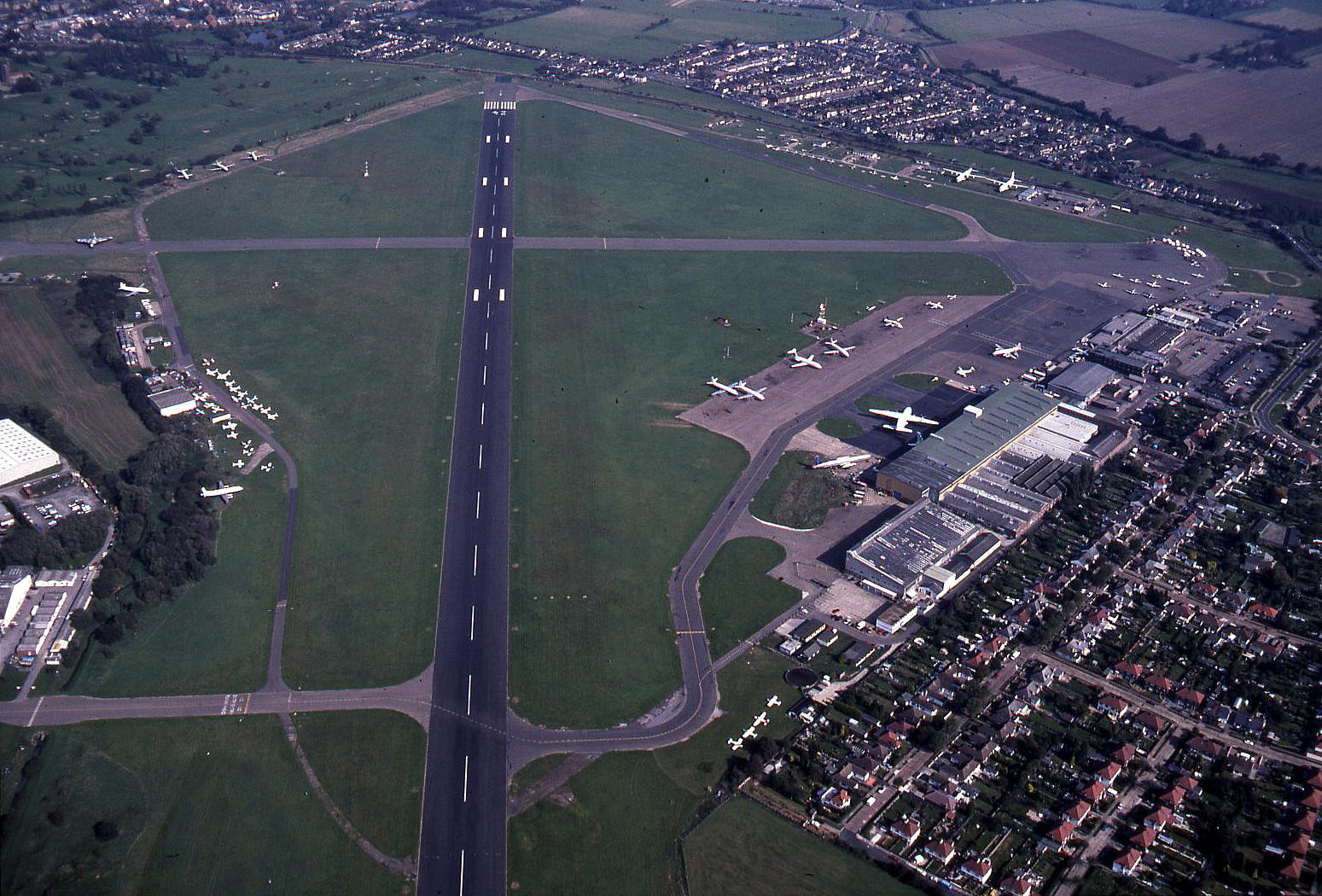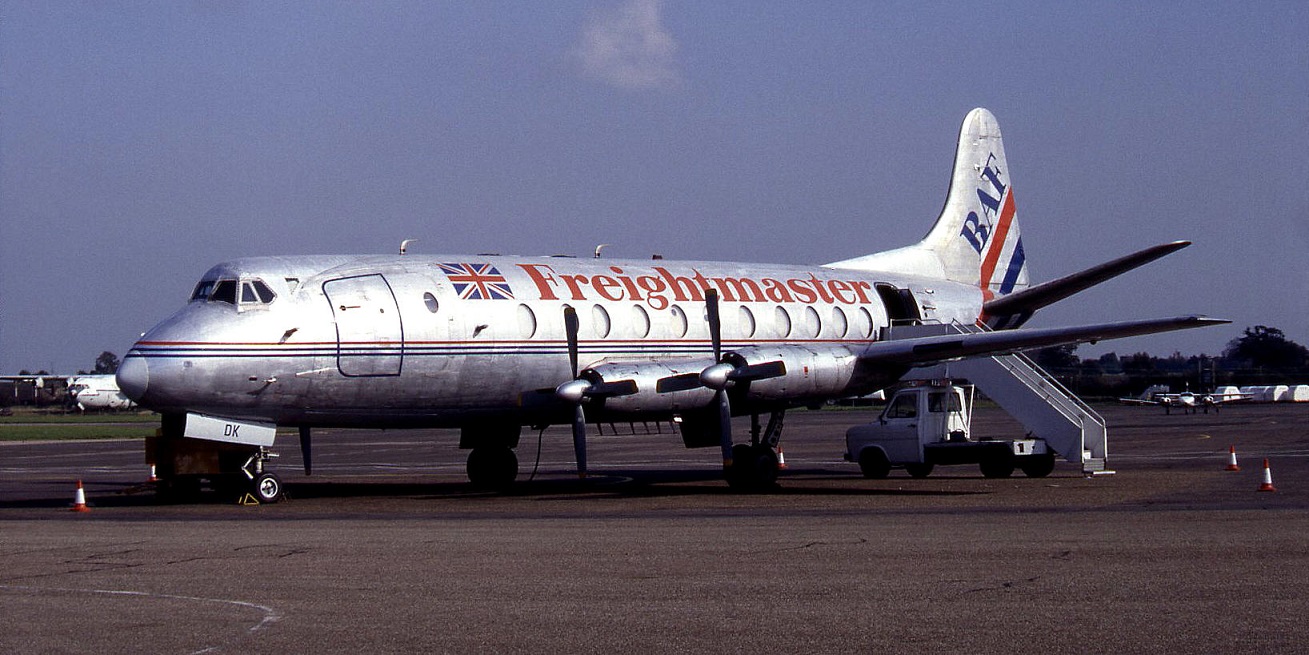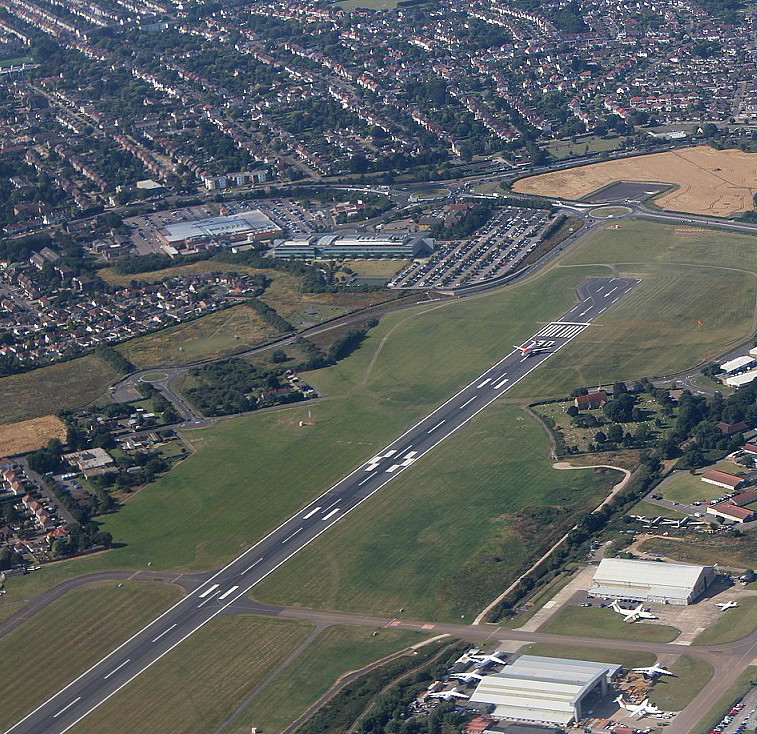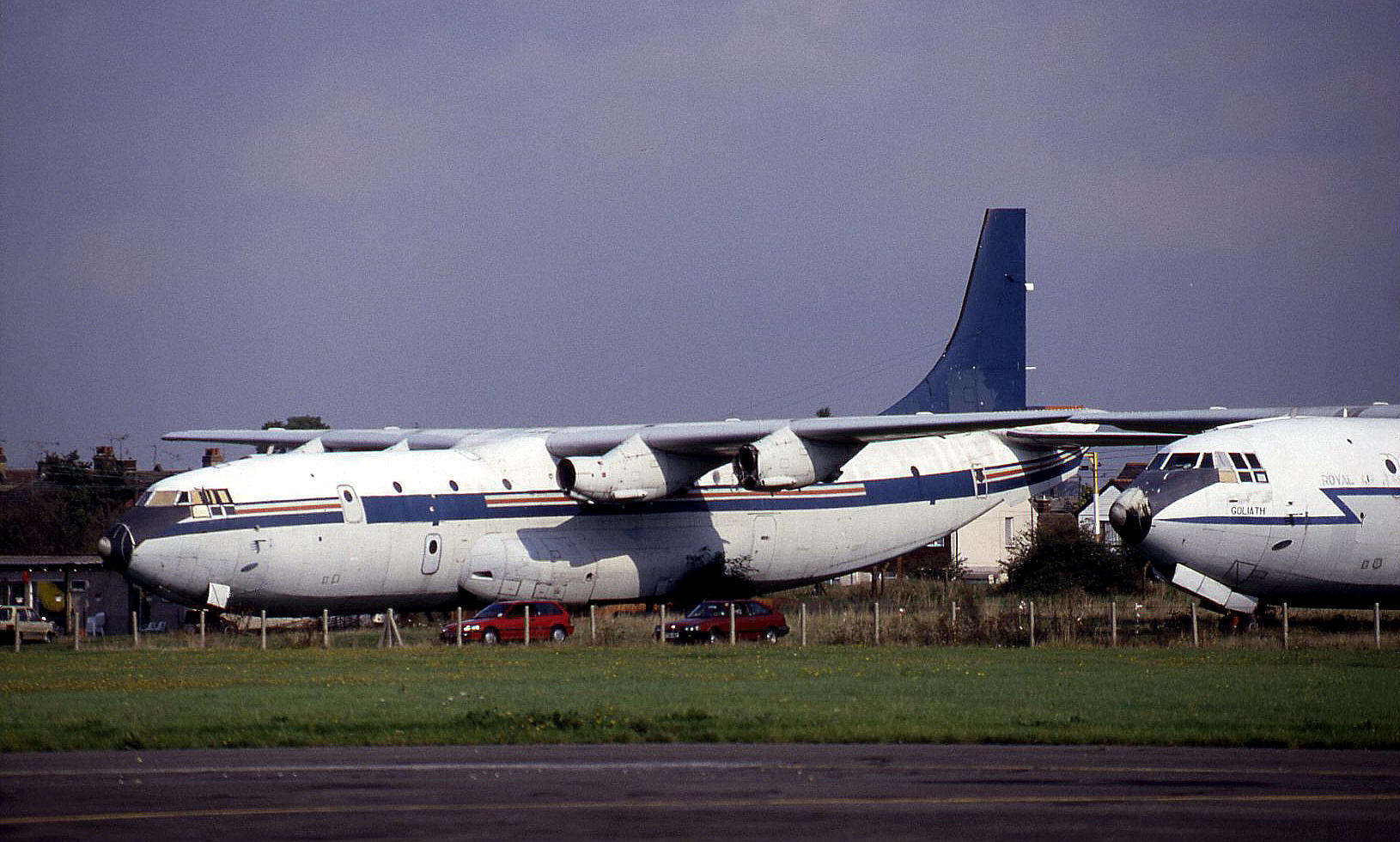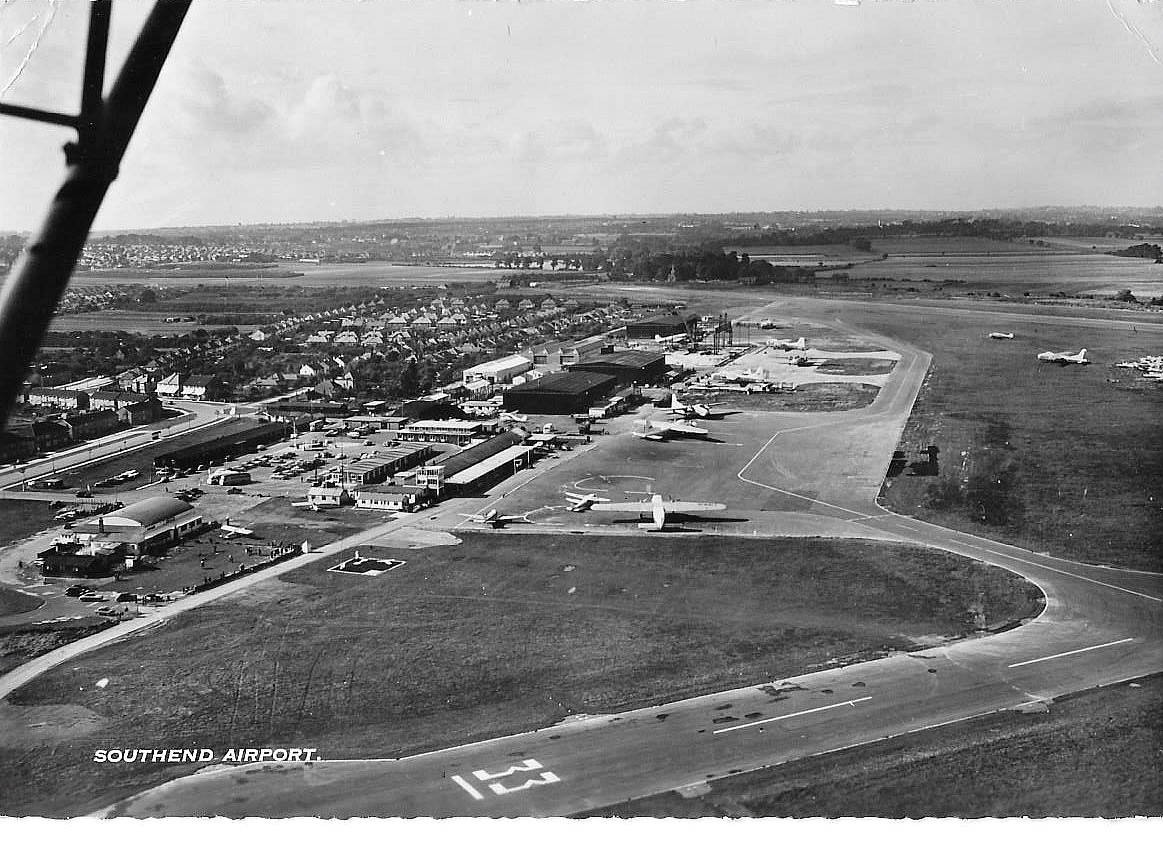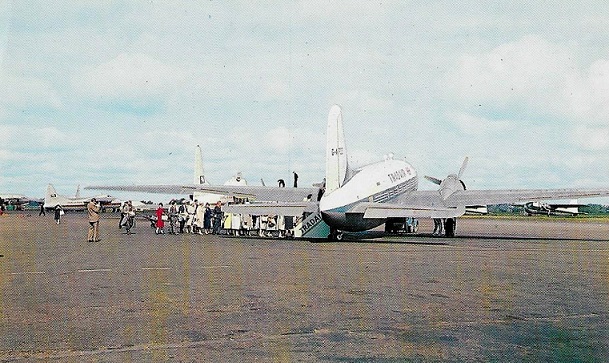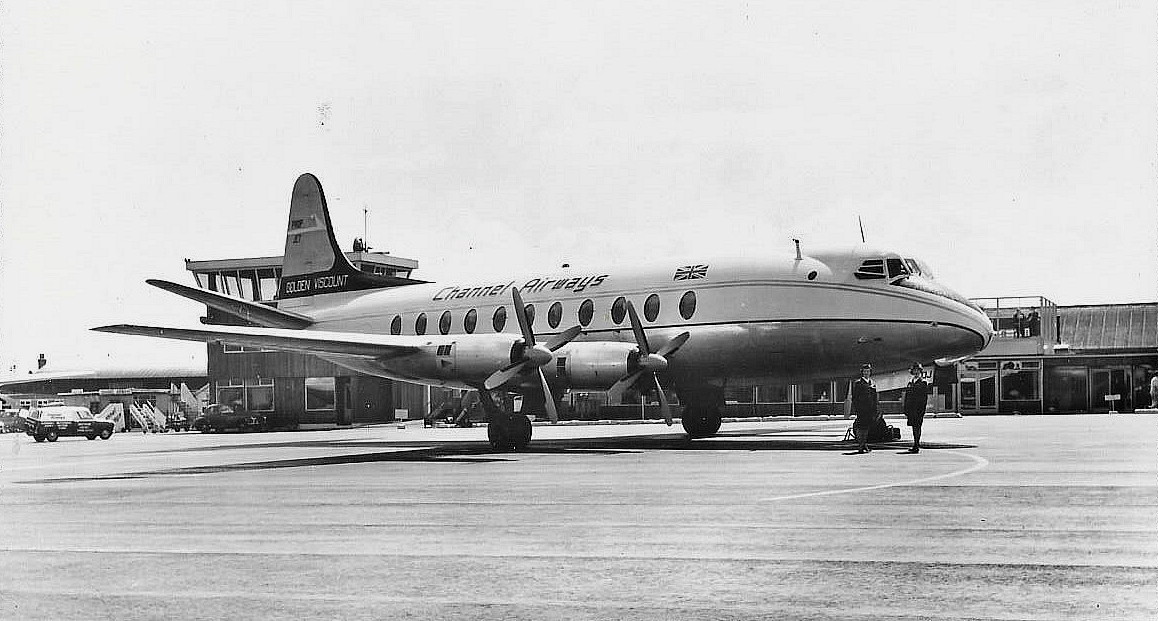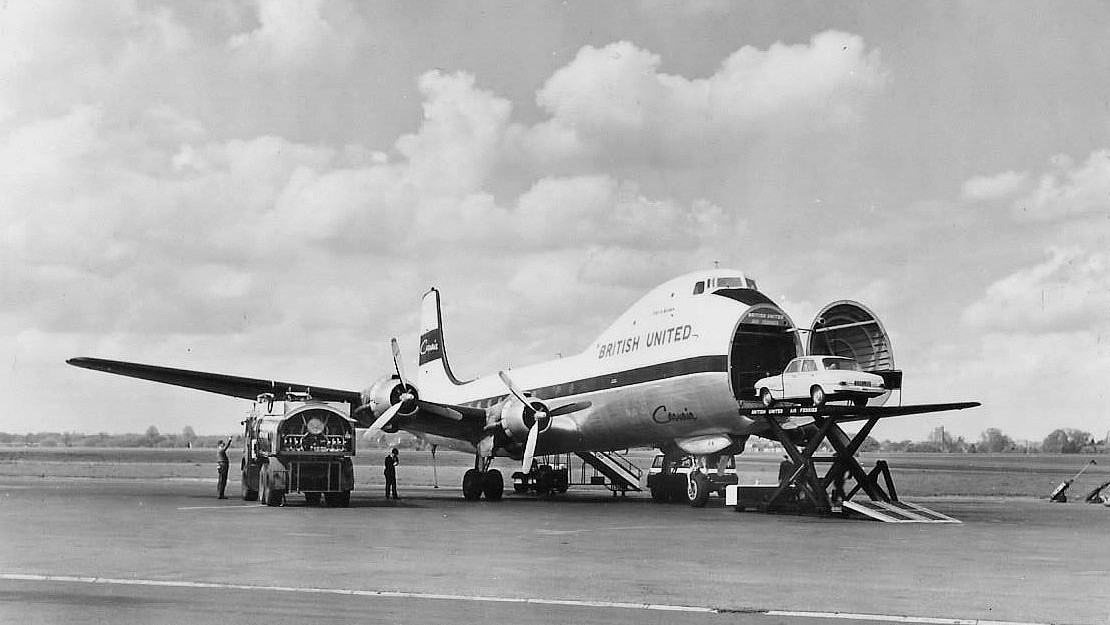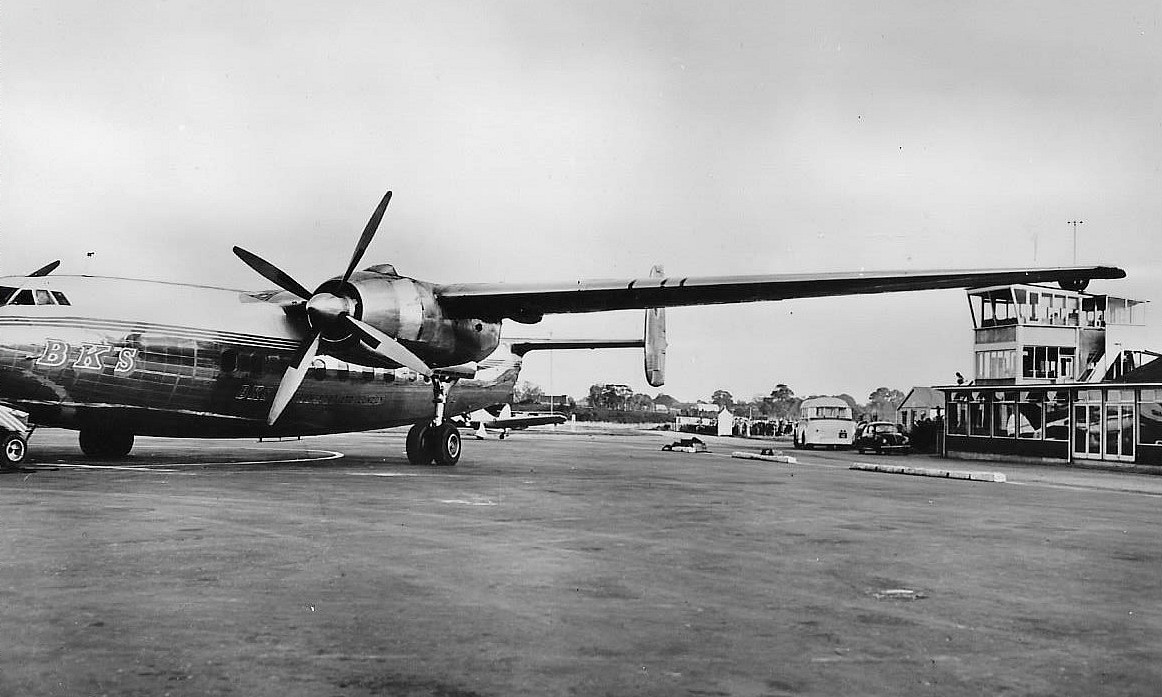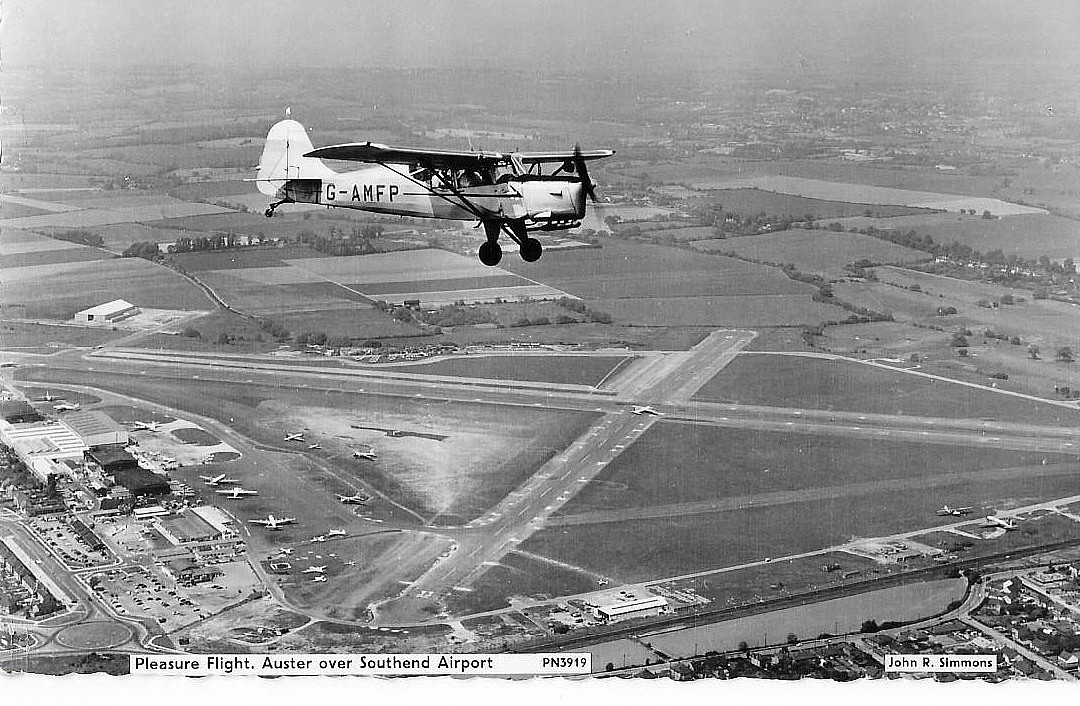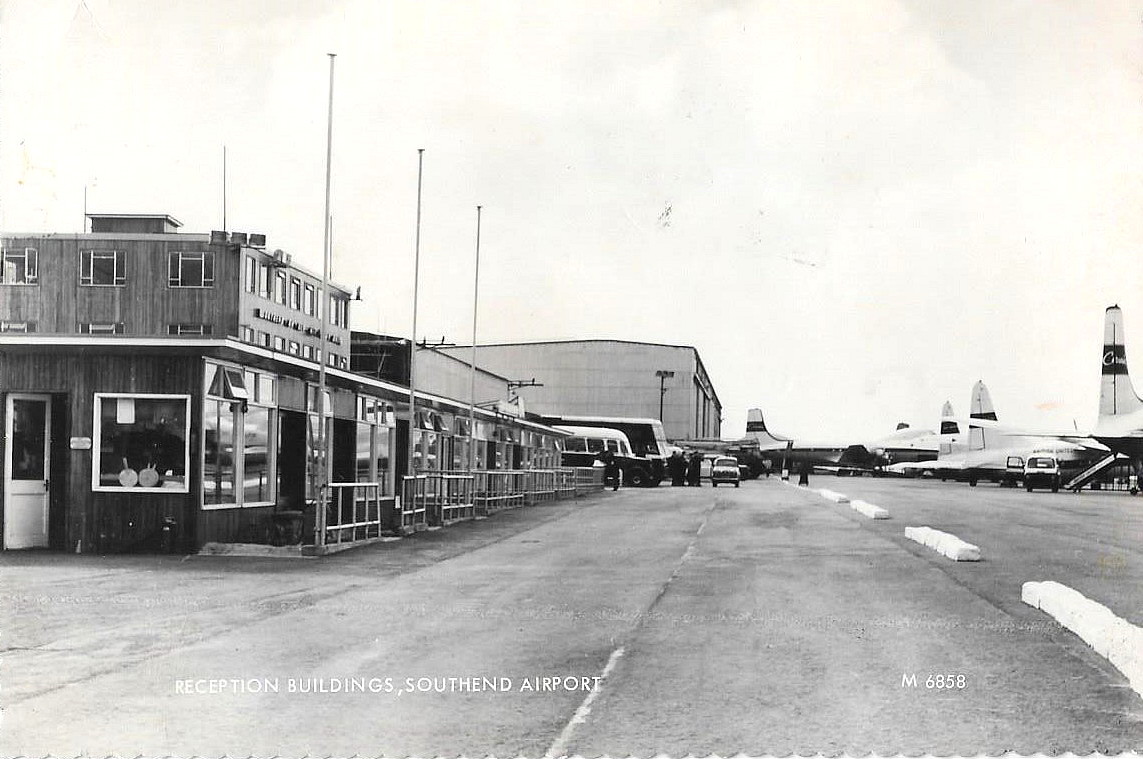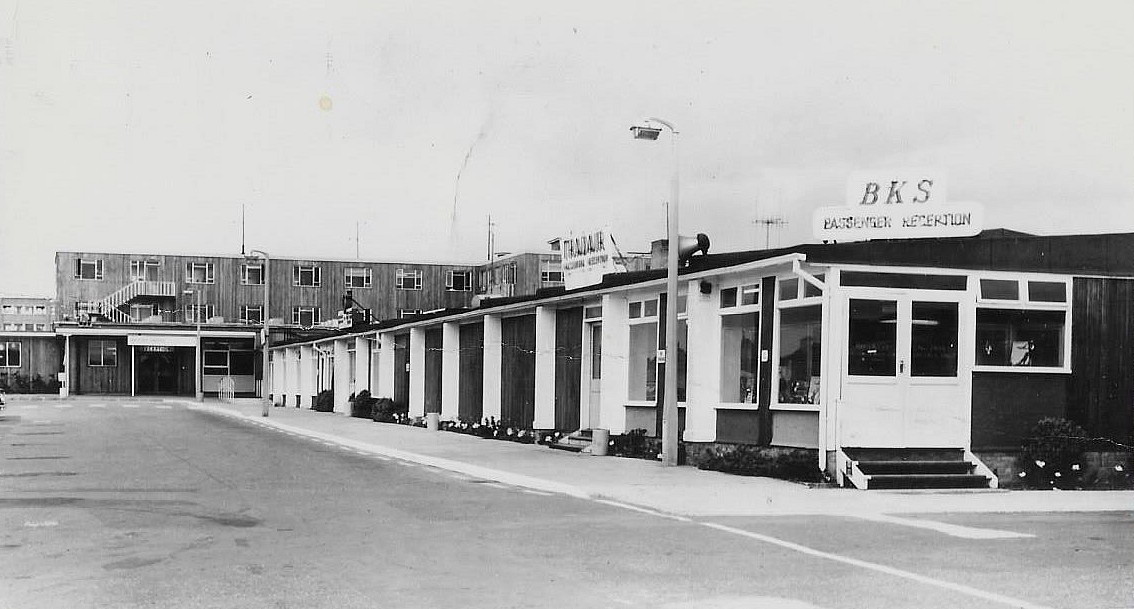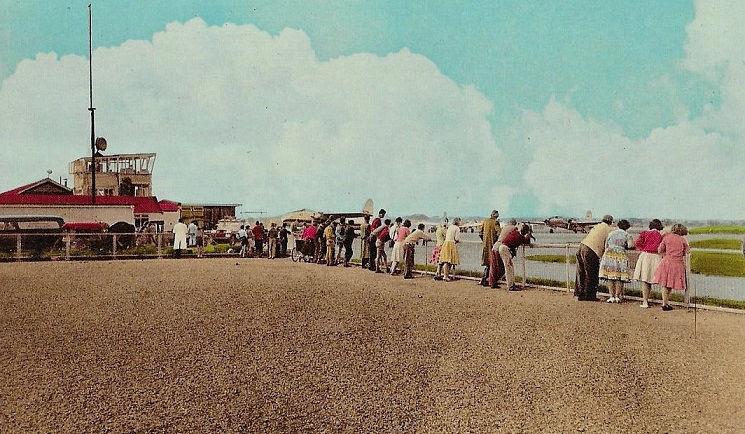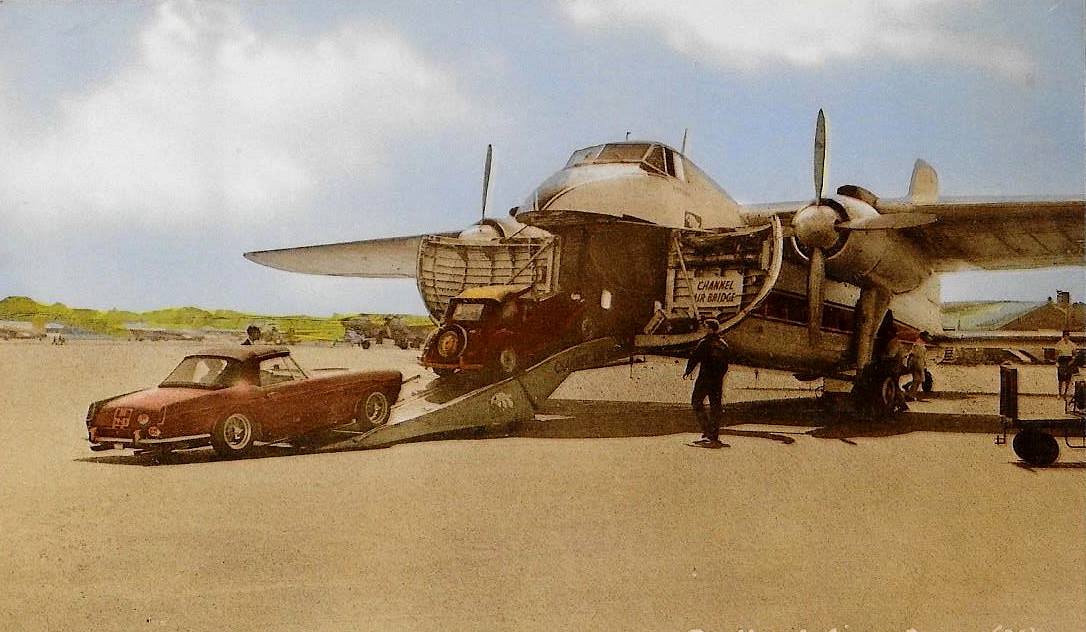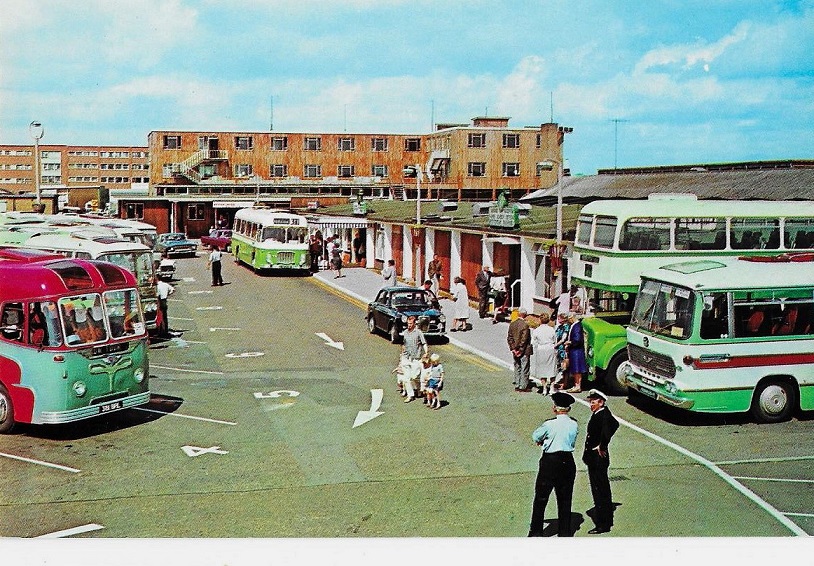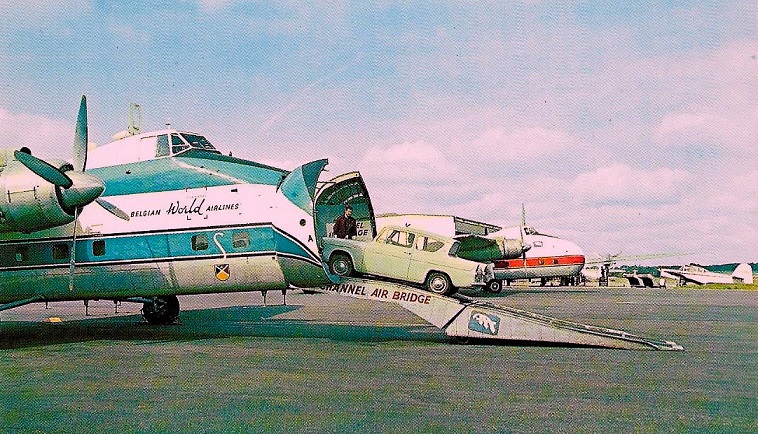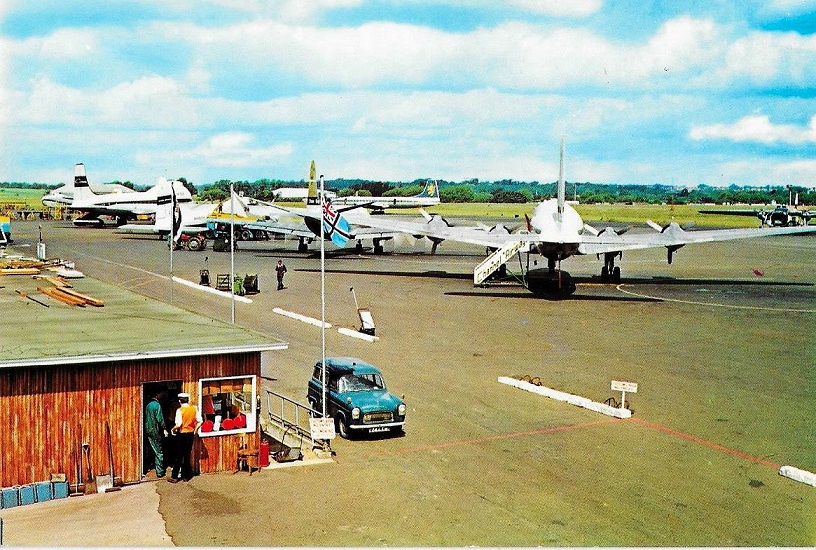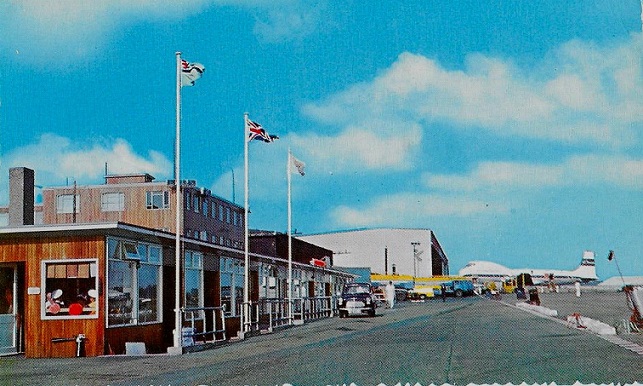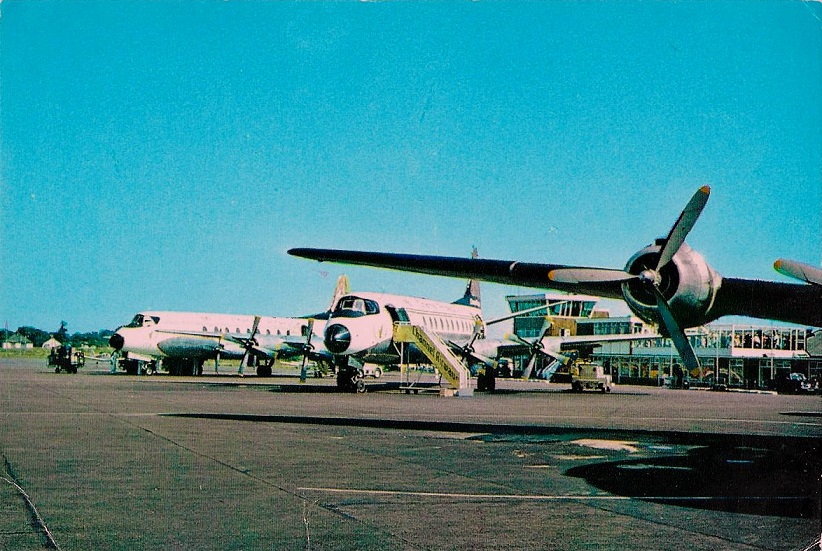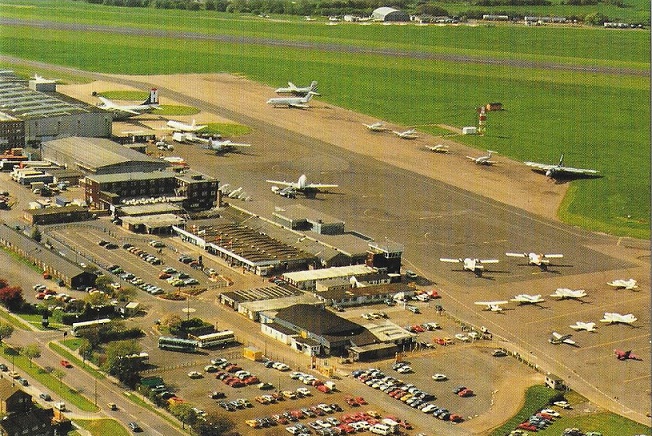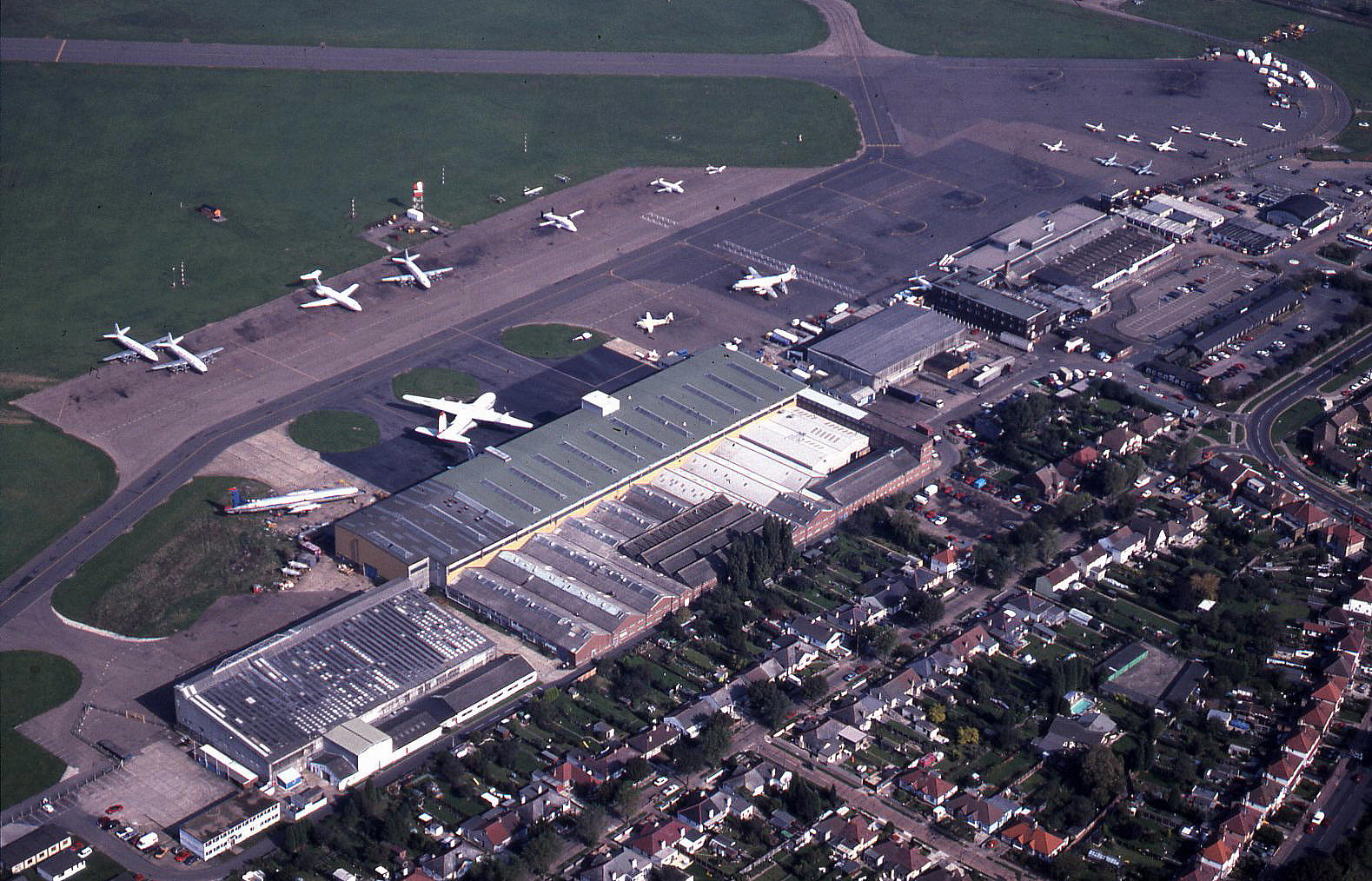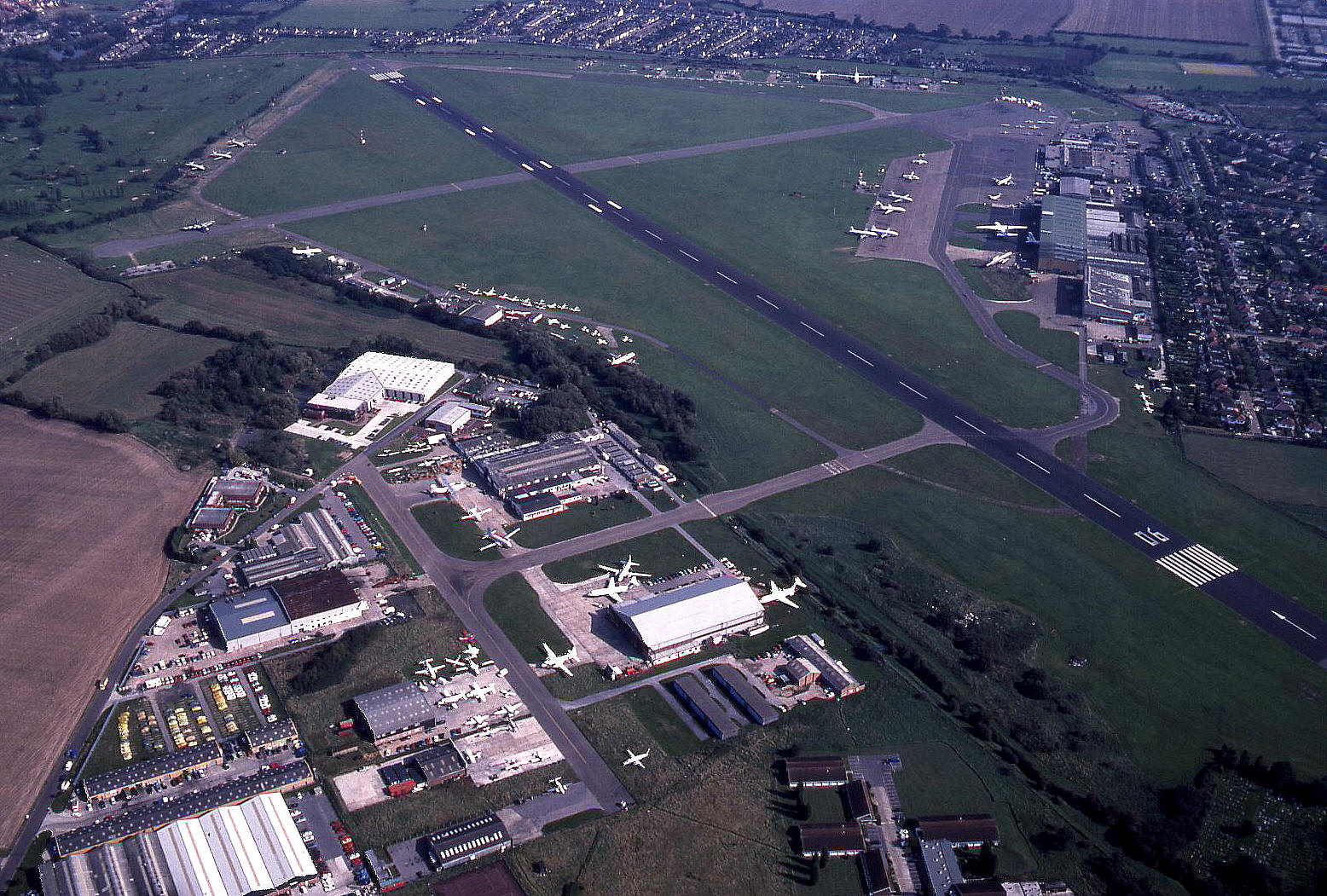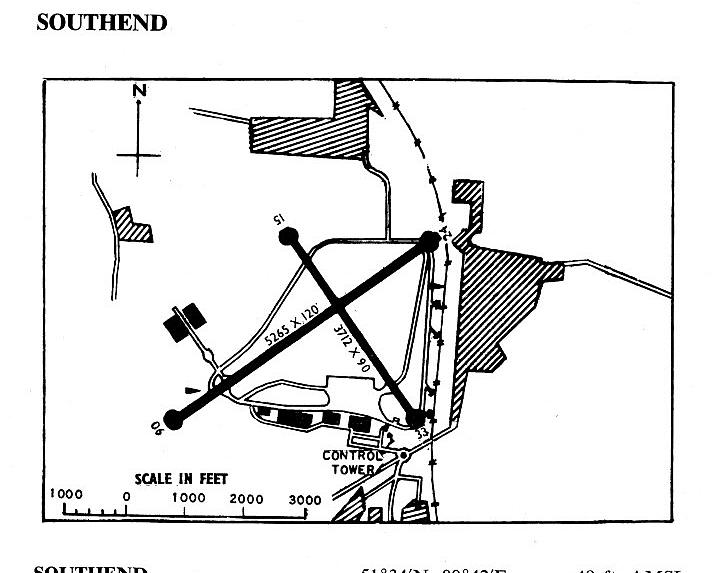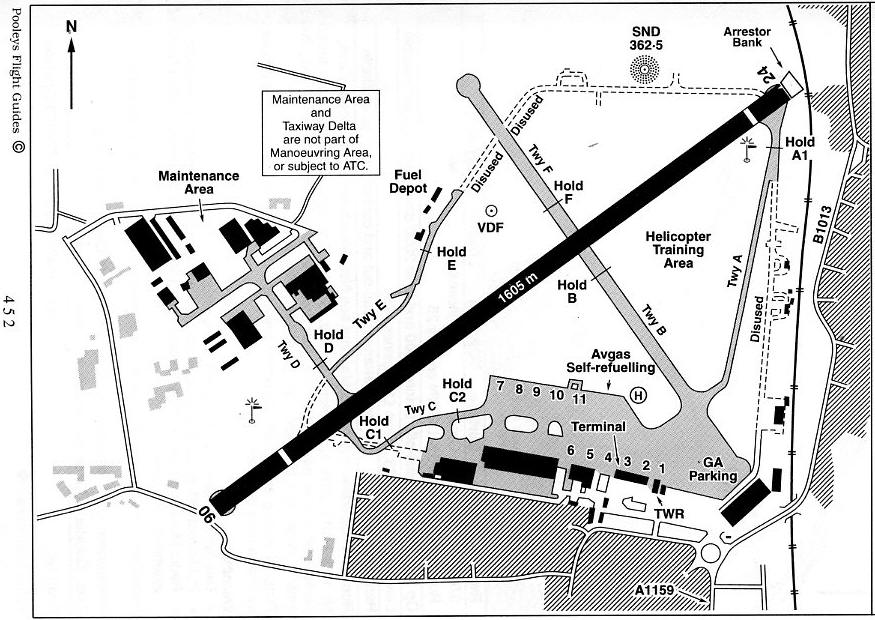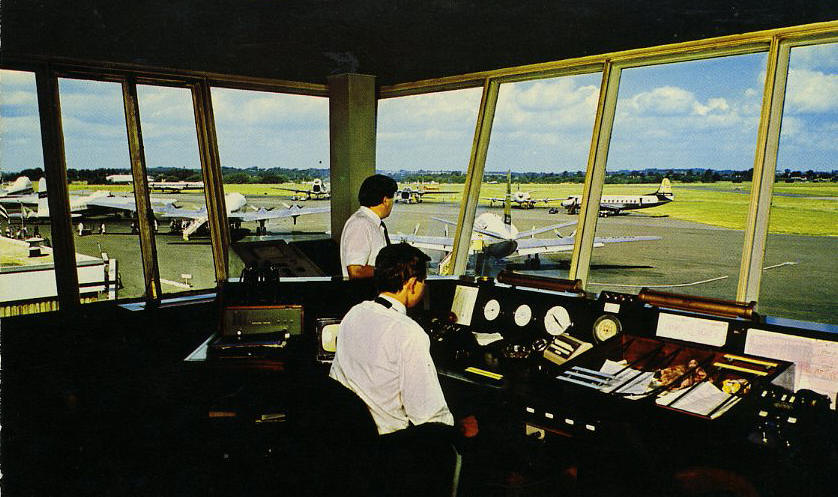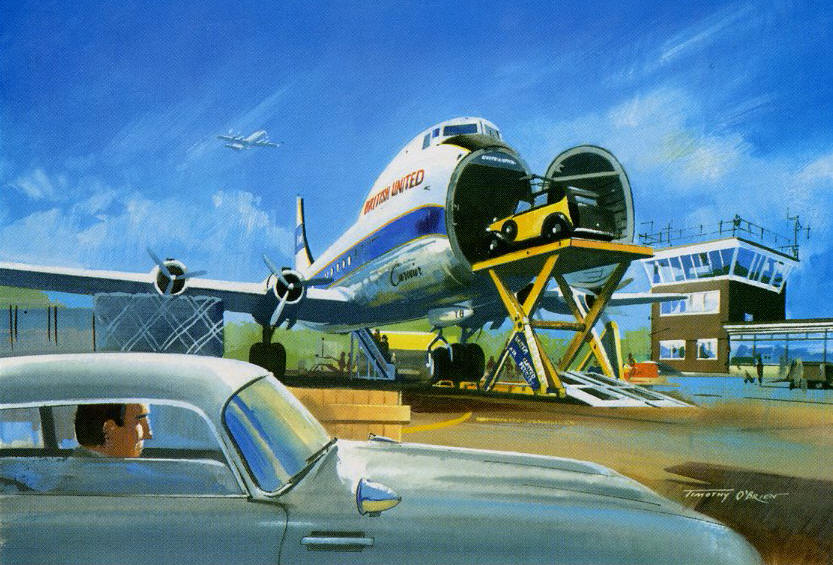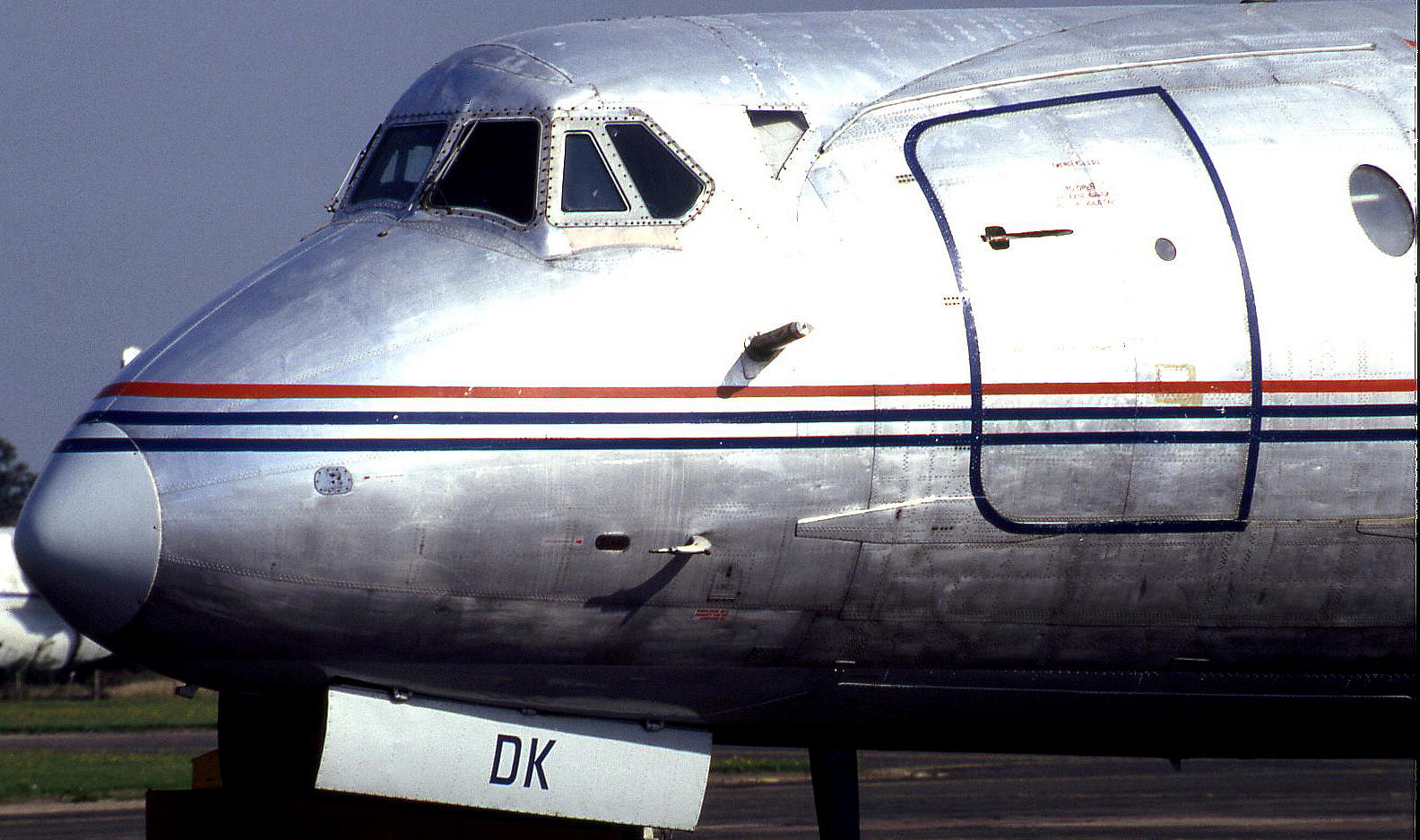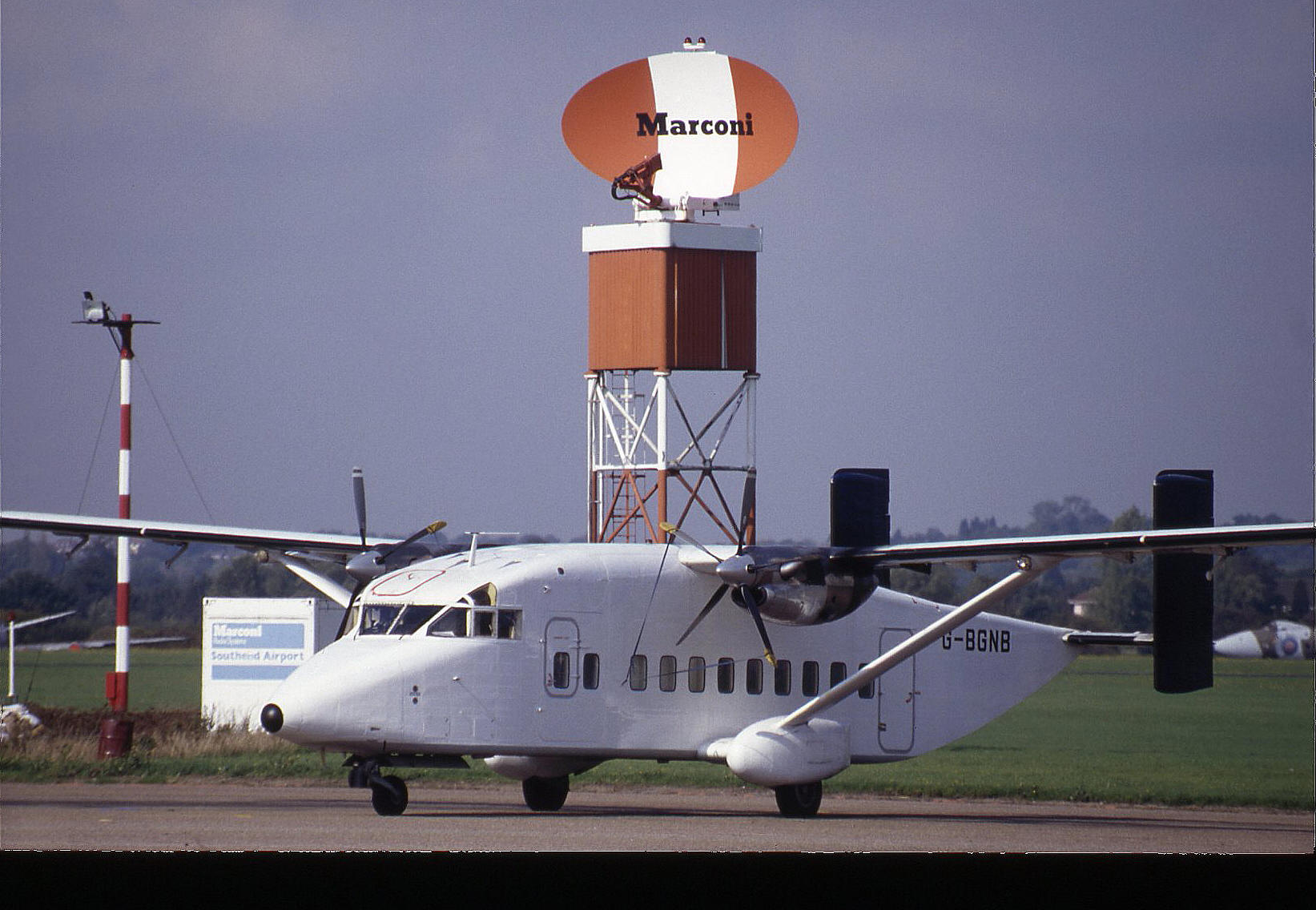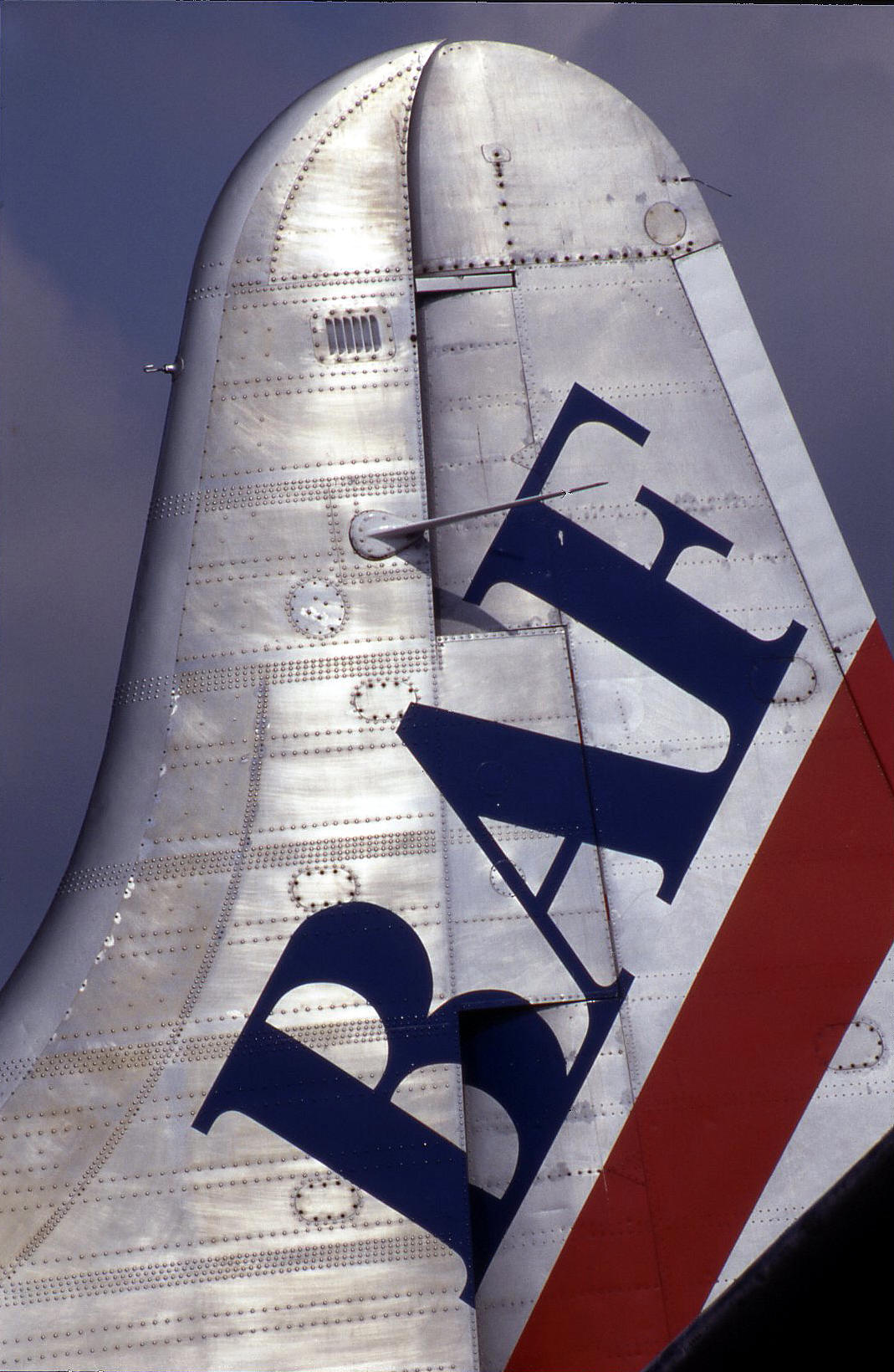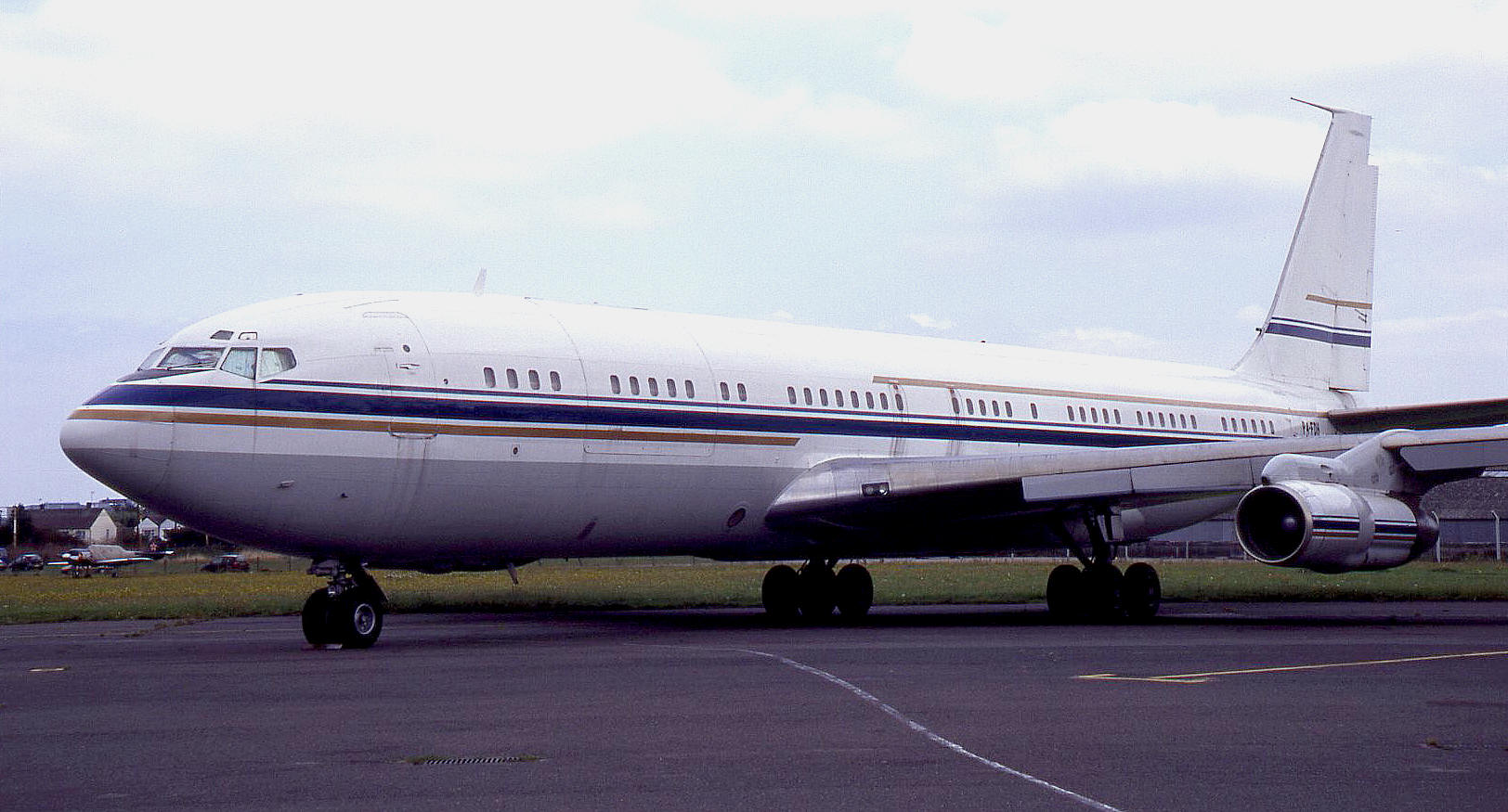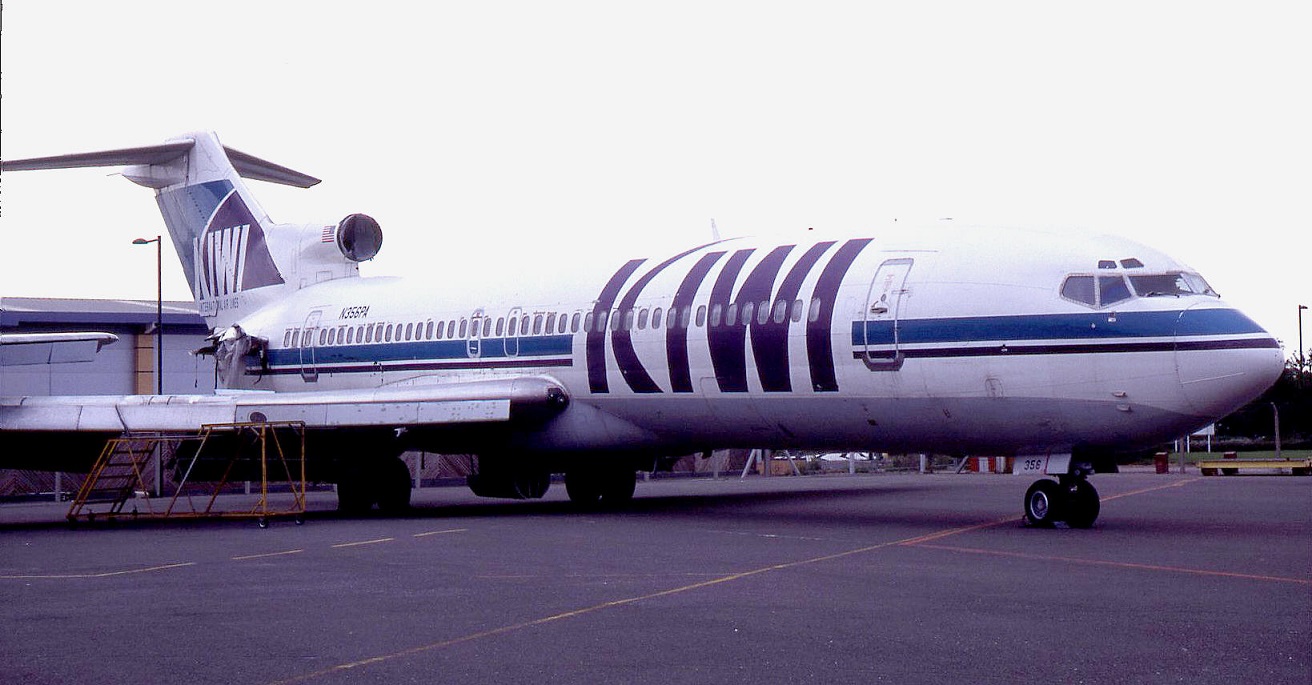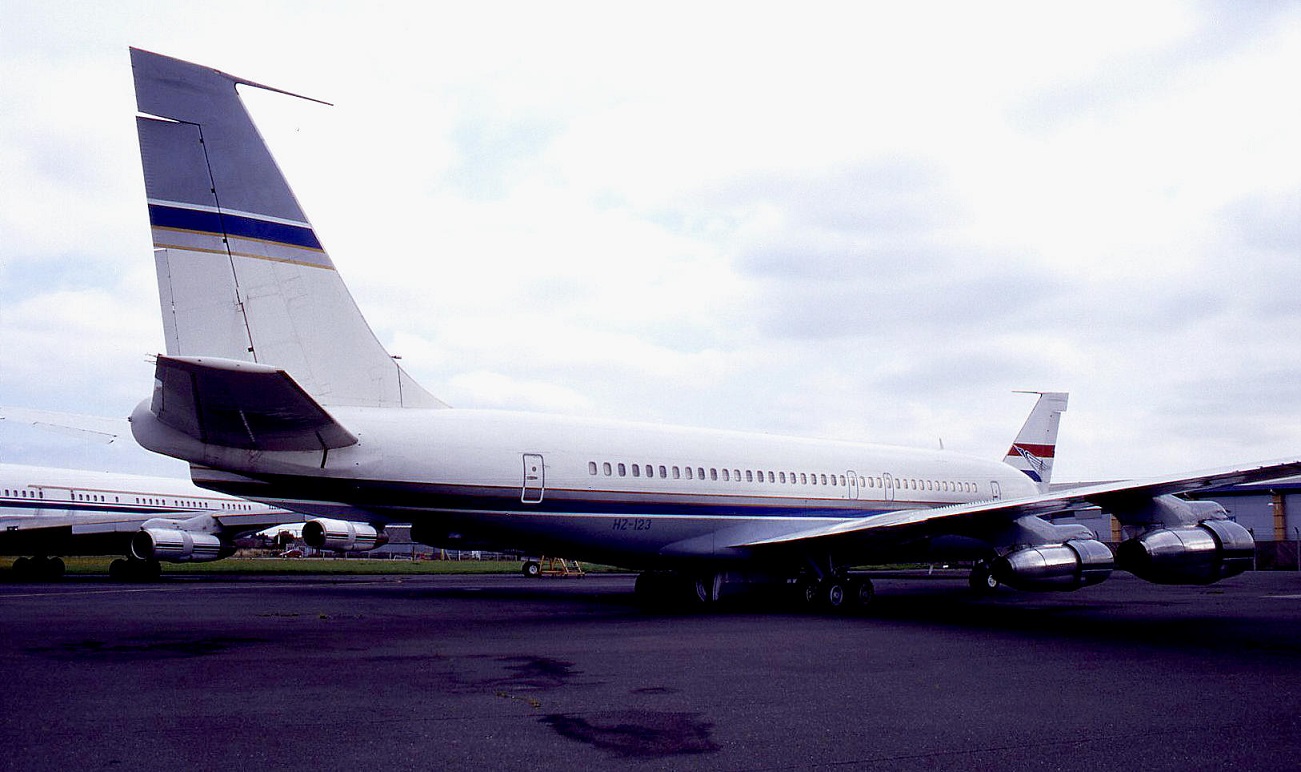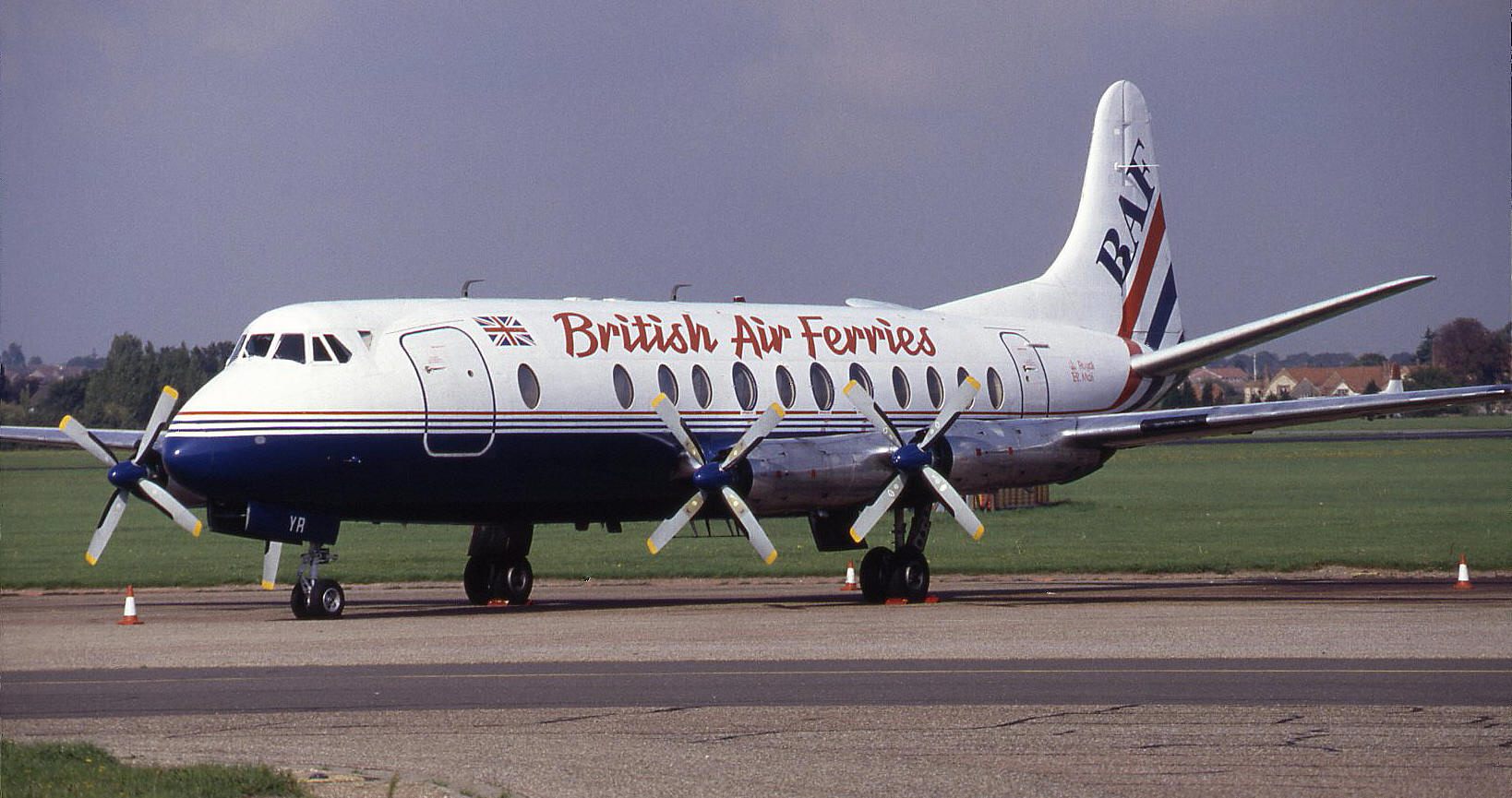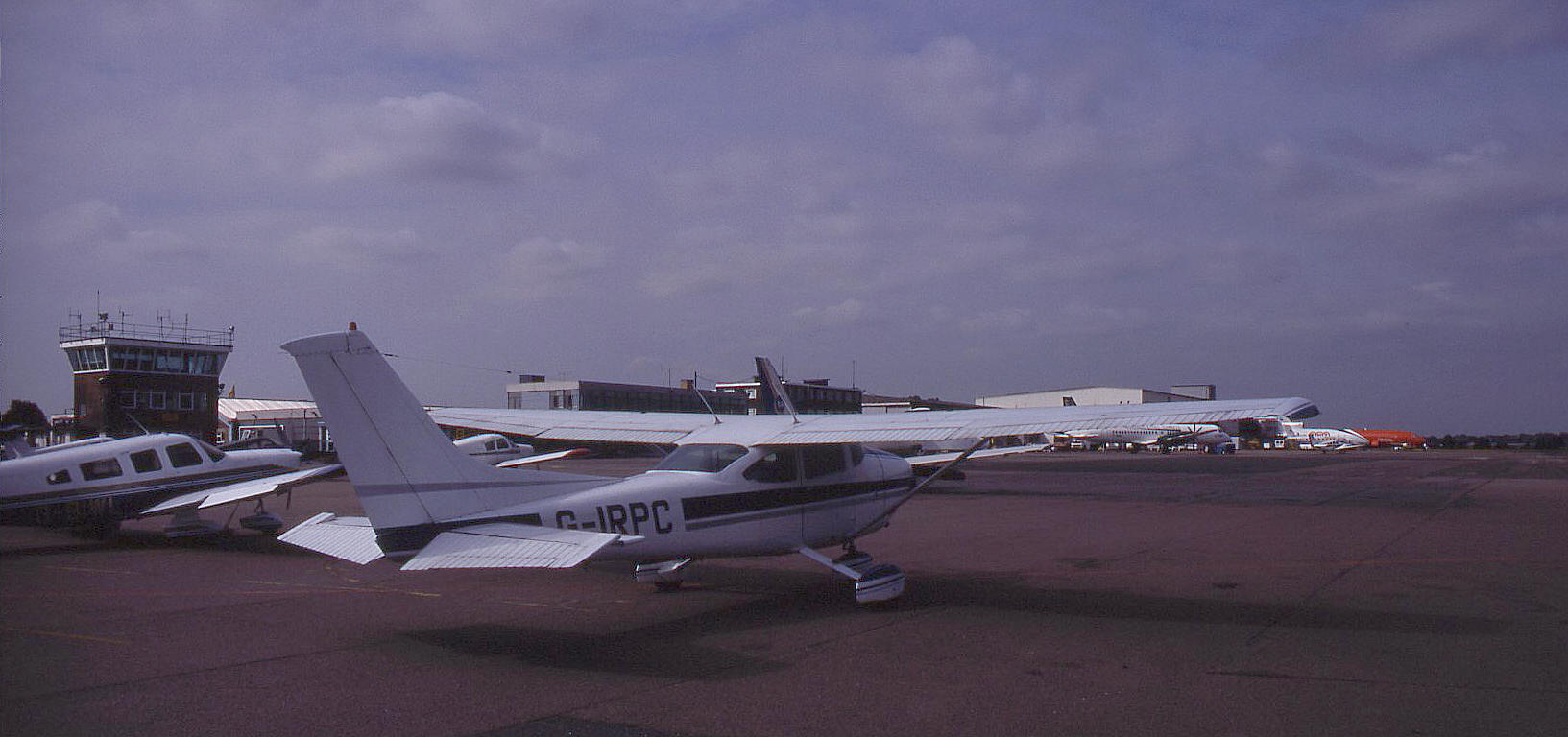Southend Airport
SOUTHEND: Originally a RNAS/RAF aerodrome in WW1. (See the ROCHFORD listing).
Civil aerodrome between the wars, becoming the SOUTHEND MUNICIPAL AIRPORT in 1935.
Note: This picture (2018) was obtained from Google Earth ©
Then military aerodrome in WW2 called RAF ROCHFORD initially but SOUTHEND by 1944, if not before. RAF ROCHFORD forms part of the airport we know today.
A MICHAEL T HOLDER GALLERY
In 2022 Mike Holder, a great friend of this 'Guide', decided to see what information was available regarding the earlier history of this location, bearing in mind that I already had the WW1 ROCHFORD Site listed. I trust you will agree with me that the results are quite astonishing. Not least finding the early history in Defending Essex which starts below.
Mike also found this photo of Sopwith Camels and Pups at RNAS Air Station ROCHFORD. Source unknown?
MAPS FROM 1920
BEFORE BECOMING THE SOUTHEND MUNICIPAL AIRPORT
This short article was published in the Kinematograph Weekly on the 20th April 1933. The location was being used before it became an airport, for several years. As noted above and below. However, this short article refers to the visit by Sir Alan Cobham's National Aviation Day displays on the 14th and 15th April 1933. This was the starting point of his No.2 Tour that year and was not at this location! See the listing for HOLT FARM situated further north.
THE BIG DAY ARRIVES, THE OPENING OF THE AIRPORT, 18th SEPTEMBER 1935
Article One was published in the Daily News (London) on the 18th September 1935. The next day, on the 19th, they published a second article, (Article Two in two parts), with a picture. That publication having the popular name of the News Chronicle.
The official opening of SOUTHEND MUNICIPAL AIRPORT clearly attracted a lot of interest at that time. The article was published in the Skegness News on the 25th September, and the short article appeared on the same day in the Tatler.
AN ARTICLE IN FLIGHT MAGAZINE
Flight magazine, being a weekly rather than daily publication, (long since monthly of course), were just a tad behind the dailys. This article appearing on the 26th September 1935.
A COUPLE OF VIEWS FROM WW2
SOME LATER VIEWS
The area view is from my Google Earth © derived database. It might be worth mentioning that far from all the flying sites listed in this 'Guide' are marked on my database.
MORE PICTURES AND INFORMATION
Note: The first picture was taken by Austin J Brown whilst I was flying. All other pictures taken by the author unless specified. With regard to the second picture it might be hard to imagine today a less likely airliner than a Vickers Viscount being used for frieght operations - but here is the proof they were.
Later regional civil airport known as SOUTHEND AIRPORT and much later, rather stupidly of course - LONDON SOUTHEND AIRPORT.
ICAO code: EGMC IATA code: SEN
Military users: 1935 to 1939: RAFVR.
In 1939 a satellite airfield for RAF HORNCHURCH
1939: 34 E&RFTS
In late 1944 SOUTHEND was listed in official records as being operated as a Balloon Storage centre
Operated by: 1920: Navarro Aviation Co?
1935: Southend Flying Club
1965: Southend Corporation
1990: Airports UK Ltd
2000: London Southend Airport Co Ltd
2005 Regional Airports Group
2008: Stobart Group
Activities: Airline, air freight, charter, car ferry, GA business, private, training, charter and air taxi. Maintenance for both light and heavy aircraft especially including conversion work from passenger to freighter duties.
British airline users: Pre 1940: Crilly Airways, Southend-on-Sea Flying Service
A MIKE CHARLTON GALLERY
These sixteen pictures from postcards, featured in two galleries, were very kindly provided by Mike Charlton who has an amazing collection. See, www.aviationpostcard.co.uk
First picture: This fabulous aerial picture shows a period in the history of SOUTHEND which is I think, largely overlooked today. This being when the airport was a very busy car-ferry terminal. As LYDD (FERRYPORT) was opened in 1954, and seeing the amount of Bristol 170 Superfreighters scattered around, I imagine that this picture was probably taken after 1954, and perhaps as late as 1961? I say this simply because there isn't an Aviation Traders Carvair in sight, and that first flew in 1961. If anybody can kindly offer advice, this will be most welcome.
Second picture. Tradair has a fascinating history, and has been described as a most successful failure! Trading from May 1958 to December 1962, and based at SOUTHEND, they had a remarkable route network flying scheduled services, I.T. (Inclusive Tours), ad-hoc passenger and freight charters. Operating during this period eventually nine Vickers Vikings with two Vickers Viscounts being added later on, they used several major UK airports to serve all across Europe from Scandinavia through to Italy, France and Spain, and indeed to the Canary Isles.
I could well be mistaken, but blowing up a segment of this picture, it looks like the first three registration letters are G-AP....? If so, this Viking was one of three acquired from the RAF Queens Flight and all registered on the 6th August 1958. G-APOO was ex.VL233, G-APOP was ex. VL246 and G-APOR was ex. VL247 It appears these Vikings were reserved for passenger operations although some of the others were converted for passenger and freight operations. When the end came with mounting debts the main assets and staff were acquired by Channel Airways.
Third picture: This is very interesting. First registered to Vickers Armstrong from the 23rd May 1952 until the 3rd November 1953, this Vickers 701 Viscount (G-AMOJ) didn't enter service with BEA until the 9th November 1953 when it continued in operation until the 14th February 1964. It was then registered to Tradair from the 14th February 1964 to the 2nd of January 1967! And yet, if you look at the information above, Tradair ceased in 1962. Clearly Channel Airways kept the Tradair company going, if only in the accounts department. It then went to Cambrian from the 13th January 1967 before being PWFU (Permanently Withdrawn From Use) on the 19th July 1971.
Fifth picture: Such a shame that some utter moron decided to chop off the nose of this classic airliner.
Sixth picture. Typically virtually nothing is straightforward in aviation history - or very little. G-AMFP was initially registered to Auster at REARSBY from the 21st October 1950 until 29th May 1951. Presumably awaiting a buyer. It then went to Aviation Traders from the 30th May 1951 to the 21st December 1955. Based mainly at SOUTHEND, can this picture date from that period?
Then, on the 22nd December 1955, it was registered to, (take a deep breath), The Mayor, Aldermen and Burgers of the County Borough of Southend-on-Sea, until the 26th of January 1966. But, did they get involved in undertaking pleasure flights? Not personally I'm fairly certain? 'MFP then went up north to the Middleton St George Aero Club (TEES-SIDE airport) from the 18th February 1966 until the 1st July 1967, when it passed into private ownership to Mr Frederick Harrison Greenwell in Sedgefield, County Durham, from the 2nd August 1967 until the 14rh June 1969.
It was then registered to the Rochford Hundred Flying Group, presumably based at SOUTHEND (?) from the 4th July 1969 until the 3rd October 1972. It crashed in St Julien, France on the 10th August 1972 but it takes official records some time to catch up.
MIKE CHARLTON GALLERY TWO
Ninth picture: Not being a fashion guru I can only guess at the rough date. Circa mid 1950s to 1960ish I suppose? What a shame that modern airports, due to heightened security concerns, no longer offer this much appreciated facility.
Tenth picture: Yet another enterprise by the far-thinking Freddie Laker, Channel Air Bridge started operations here in 1955, a sister company to Air Charter. They had four Bristol 170 Freighters and services eventually included Calais in France, Oostende (Ostende) in Belgium and Rotterdam in The Netherlands. Both became part of the Airwork group in 1959 and in 1960 Airwork joined with Hunting-Clan to form British United Airways. In 1962 BUA was merged with Channel Air Bridge and Silver City Airways to create British United Air Ferries in 1963.
Therefore this picture is probably from the mid to late 1950s? The original Freighter could only carry two cars plus passengers, but with the extended nose and other modifications the later Superfreighter could carry three cars plus passengers.
Eleventh picture: Circa mid 50s to early 60s perhaps? I suppose you have to be of a certain generation, the post WW2 'baby boomers' like me, to get a tad dewy eyed about a picture like this? These coaches and buses, usually very under-powered on steel suspension, were real bone-shakers, but we loved them. A coach journey for most of us - was heralding an adventure!
Twelth picture: What a corker, and possibly a rather rare picture? I knew that Sabena, the Belgian national airline, had collaborated with Channel Air Bridge on services to Oostende (Ostende) but had no idea that at least one of the Superfreighters was painted in their colours. The Superfreighter seen beyond is also a Channel Air Bridge example. What interests me, a bit anyway, is the Ford Anglia being loaded - hardly the vehicle of choice for the well-to-do at that time.
And, note the Percival Prentice on the right. Quite probably an example of one of Freddie Laker's many commercial flops, although, as usual, the basic idea seemed to have obvious merits at the time. In 1956 Aviation Traders brought 252 Percival P.40 Prentices from the Air Ministry for £5 each. I suppose the scrap value was higher? They were delivered to STANSTED and SOUTHEND.
Part of the idea was to convert some of them for civilian use as a four/five seater tourer for private use and groups and clubs. Despite having heavy fuel consumption, this was still attractive to some and it appears, twenty eight were sold for £2000, later reduced to £1500, in the 1956 to 1958 period. The problem being that when U.S. dollars became available, Mr Tim Vigors started importing the Piper PA-22 Tri-Pacer into CROYDON, also for £2,000, and the fate of the civil Prentice was sealed for good, the American type being much, much cheaper to operate. And of course, so much more desirable.
Thirteenth picture: From right to left the first aircraft is almost certainly a Channel Airways Douglas DC-4, probably about to embark on an I.T. (Inclusive Tours) service to somewhere in deepest, darkest Europe. I say darkest because most of the returning passengers looked like they'd come from living in India! Next is a Channel Airways 800 Series Viscount, still mostly wearing its Continental Airways livery from the USA. Channel Airways saved a lot of money by using much of the previous owners livery, and, operated at least twenty Viscounts. The first nine being 700 Series (seven ex-BEA), then eleven 800 Series from Continental.
Next in line is a British United Air Ferries (BUAF) Bristol 170 Superfreighter and then a BUAF Aviation Traders Carvair. In the background are a couple of Bristol Freighter types, probably BUAF, and a Caledonian Airways Bristol Britannia. The reason that I'm fairly certain that this picture dates from the mid to late 1960s is simply because Caledonian operated nine Britannias from 1964 until 1971.
Fifteenth picture: Trying very hard to be an 'anorak', (although expecting to be trashed), I reckon the further Viscount in this picture could well be G-APTA, operated by Channel Airways from the 7th August 1959, and previously operated in the Bahamas as VP-TBK, but clearly still wearing mostly Continental Airways livery. Oddly perhaps, a 'one-off'' purchase registered after Channel Airways had started acquiring 800 Series Viscounts. It appears it was re-registered in the Bahamas as VP-BBW from the 21st June 1961 until being restored to the UK register on the 16th December 1964.
And then going back to the Bahamas as VP-BBW from the 31st December 1965 until the 18th July 1967 when it returned to the UK, being WFU (Withdrawn From Use) at SOUTHEND on the 13th July 1969. Quite why anybody would deliberately plan to withdraw an airliner at the height of the main holiday season totally escapes me - having been in business for nearly half a century. It smacks of utter incompetence. But, it has to be said, when the history of so many British airlines is now being examined, the degree of incompetence at senior management levels almost beggers belief. Mind you, many if not most of the employees at British Airways in 2018, could offer a very convincing argument that the tradition still applies!
The wing and, (for me at least), fabulous radial engine, belongs to a BUAF Carvair. (Look at the shadow).
Sixteenth picture. Last but not least by any means. If anybody can kindly offer advice, this will be most welcome. My guess is that this picture was taken in 1987, after the Vulcan XL426 had arrived, and clearly seen in this picture. A Heavylift Short Belfast is also seen awaiting attention, but, unless I am mistaken, there appears to be two Twin Otters on the main apron. If I am correct, can anybody kindly explain what these aircraft were doing?
Post 1945: Air UK, BKS Air Transport, British Air Bridge, British Midland Airways, Channel Airways, CityFlyer Express, East Anglian Flying Services, easyJet, Flybe, Guernsey Airlines, Northeast Airlines, Region Airways
Note: In the 1957 edition of The Aeroplane directory, B.K.S. Air Transport are listed as having a fleet of five Douglas C-47 Dakotas, four Vickers Vikings, one Airspeed Consul and one Avro Anson. Their flying bases were here. YEADON and NEWCASTLE.
The East Anglian Flying Services fleet was three DH104 Doves, three DH89A Dragon Rapides, two Percival Proctors, two Austers and one DH82A Tiger Moth. Their flying bases were; SOUTHEND, IPSWICH, SHOREHAM and PORTSMOUTH. They also operated the East Anglian Flying Club.
Foreign airline users: Post 1945: Aer Arran, Air Malta, Fred Olsen, Holland Aero Lines, Sabena
Car ferry: Post 1945: British United Air Ferries previously Channel Air Bridge
Cargo, charter, air taxi: Post 1945: ACE Freighters, Air Charter, Air Condor, Aircruise, Air Safaris, Baron Air Charter, BKS Aerocharter, Bond Air Services, British United Air Ferries (aka British Air Ferries), British and Continental Airways, British Nederland Air Services, Channel Airways, Crewsair, Dan Air, East Anglian Flying Services, Eros Airlines (UK), Hot Air, Jota Aviation, Macedonian Aviation
Flying schools and Groups: Post 1945: Direct Helicopters, Municipal Flying School (1947 to 1964), Rochford Hundred Flying Group, Seawing Flying Club, Southend-on-Sea Municipal Air Centre and Flying School, Southend Flying Club, Southend School of Flying, The Flight Centre, WillowAir Flying Club
Notes: In the 1957 'The Aeroplane' directory, the Southend-on-Sea Municipal Air Centre and Flying School were listed as providing instruction in Commercial and Private Pilots' Licenses, instructors' certificates, R/T licences and night ratings. Their fleet was one Auster J/5 Autocar, three Auster J/1 Autocrats and one Auster 5.
Helicopter ops: Southend School of Flying & Direct Helicopters
Pollution control: Harvest-Air
Maintenance: Post 1945: Aviation Traders, BKS Engineering, Crewsair
Manufacturing: Post 1945: Aviation Traders (Engineering) Ltd
Pleasure flights: British and Continental Airways, East Anglian Flying Services
Location: SSW of Rochford, E of Rayleigh, 2.5 nm N of Southend
Period of operation: Opened in 1915 for military flying until 1918? Civil: 1935 to 1939
Military: 1939 to 1945 Civil: 1947 to present day
Note: These maps are reproduced with the kind permission of Pooleys Flight Equipment Ltd. Copyright Robert Pooley 2014.
Runways:
WW2: NE/SW 1189 grass E/W 1006 grass
1965: 06/24 1605x37 hard 15/33 1131x27 hard
1990: 06/24 1605x37 hard 15/33 1131x27 hard
2000: 06/24 1605x37 hard
NOTES: AIR RACING
In 1953 the annual King’s Cup Race was held here, the venue given as ROCHFORD, for the one and only time. The race was held on the 21st June and only twelve aircraft competed over the sixty mile course. Prior to WW2 the course once extended to 1,443 miles. The winner in this race was Mr W. Fillingham flying the DHC.1 Chipmunk 22, G-AKDN, averaging 142 mph. Having flown in at least four Chipmunks this feat seems quite extraordinary and he must have had the throttle ‘fire-walled’ throughout – yet another testament to the DH Gipsy series of engines being regarded as bullet-proof.
AVIATION TRADERS
The very imaginative, if not revolutionary DC.4/C.54 based Carvair designed and built by Aviation Traders based here and at STANSTED did succeed in service. Twenty-one were converted capable of carrying five cars plus twenty-two passengers in the car ferry role and sold to British Air Ferries, Aer Lingus, Ansett-ANA and Aviaco. The roughly contemporary emergence of both Ro-Ro ferries and car hire companies put paid to this expensive mode of transport. The first Carvair G-ANYB first flew on the 21st June 1961. Rather oddly perhaps, its other main advantage of being able to move large indivisible loads, went largely unappreciated? This said the payload potential was probably too restricting?
The companies only attempt at an original design was the Accountant, a project which failed miserably, and, surely it couldn’t have been solely the fault of being given such a dull name? The one and only prototype G-41-1 (later G-ATEL) – first flew on the 9th July 1957 but was grounded when the huge development costs threatened the future of the company. It appears they couldn’t interest larger British manufacturers in the project. They were already in decline to some extent but some had better designs, the Avro 748 and Handley-Page Herald for example, and I suspect the original 28 passenger payload was already insufficient for an aircraft of this size?
The last major project the company undertook was converting ten BEA Vickers Vanguards to freighter duties, called ‘Merchantmen’ and the first example, G-APEM flew on the 10th October 1969. Ron Smith says the last flight was by G-APEP which flew into BROOKLANDS in October 1996 to join the museum.
MORE NOTES
Many years ago I made this comment: Trying to ascertain the exact history and pedigree of this site has been difficult to say the least. You really would think, (as I did when starting research for this 'Guide' over twenty five years ago), that such a well known airport would have a history chronicled with masses of accurate supporting evidence. Much of the ‘info’ I have found seems to muddy the waters rather than give a clearer picture. (Hopefully by 2024 largely cleared up?)
The first mention of ROCHFORD AERODROME for civilian use I’ve found is as a venue for a month or so by pilots Mr Thompson and Mr Nicholson of the Navarro Aviation Co in 1920 flying two Avro 504K three seaters. Opening venue also, (31st March to 2nd April), for the Flying Fair 1934 Tour of the UK. Little seems known about how far they travelled or whether it was successful or abandoned part way through as might well be the case.
I have found a report that in 1932 the Southend Flying Club moved to an airstrip in the centre of the old ROCHFORD pony track on the Ashingdon road - see ASHINGDON for a bit more info. When here it seems they re-equipped with a Spartan three seater, a Blackburn Bluebird III, a DH.60 Moth which Lady Bailey had flown from South Africa to CROYDON in 1928, a DH60G Gypsy Moth built by students at the DH Technical School and a new Avro 638 Club Cadet. This seems to be a separate site near to but separated from the present airport which, although brought by the Southend Corporation in 1933 didn’t open officially as their Municipal Airport until 1935. It was however common practise in those days to use “airports” long before they were officially opened
In the summer season of 1933 and 1934 Southend Flying Services, (who by now were also managing the Flying Club), had aquired a DH84 Fox Moth G-ACEB and, in conjunction with Short Bros, (operating a Short Scion 1 G-ACJI, sometimes flown by their test pilot Mr H L Piper), operated an every hour ‘on-the-hour’ shuttle service from Southend to Rochester. It seems that officially SOUTHEND MUNICIPAL AIRPORT was opened on the 18th September 1935 by Sir Philip Sassoon, Under Secretary of State for Air, who arrived in his private DH85 Leopard Moth.
It seems confirmed that this new airport at Warners Bridge was indeed the same site as the WW1 military aerodrome. The opening seems to have been a pretty grand affair with a DH86B of British Continental Airways, Tom Rose in the Kings Cup winning Miles Falcon, E W Percival in a Mew Gull and a banner towing Avro 504N. In addition to these interesting attendees a B.A. Eagle and Swallow, Monospar ST.25, Miles M.5 Sparrowhawk and Cierva C.30A auotogyro also attended. Three Avro Club Cadets of the Southend Flying Club flew past in formation. I do know it’s hopelessly sentimental - but isn’t it lovely to now try and envisage this scene?
PRESERVING THE PAST
There are many accounts which now make, to say the least, interesting reading regarding how many light aircraft survived WW2 when officially, or so it appears, all light aircraft had to be impressed into military service. There are tales of owners, knowing full well that their beloved aeroplanes would quickly be destroyed by the RAF, being hidden away in barns and garages etc. Fortunately for us today many private aircraft, often rare if not unique examples, did survive the very deliberate destructive mangle devised during WW2, but, many singular and very important types perished.
We need to remember of course that when fighting a war, when it was generally percieved we were close to defeat; a prospect the RAF faced in 1940 for example, I imagine there was no room for any sentiment at all. Along with many other interesting aircraft types which were smashed up in about 1939/40 were two Zlin 12s acquired for Civil Air Guard training operated at SOUTHEND by the Southend Flying Club? Just the fact that people in aviation in the 1930s in England were doing deals with Czechoslovakia proves a very important point doesn’t it? Almost from it’s outset aviation has been a truly international business and has transformed the world we now live in. It seems that the remains of the Zlins were stored in a derelict property in Westborough Road, Southend, until taken to Newmarket and dumped in 1941/42. This strikes me as being an odd tale at best; why on earth should they have taken so much trouble?
A WWII DETAIL
What has interested me was the fact that in late 1944, and being a balloon storage centre it would appear, according to official records, 1558 RAF personnel where stationed here plus 173 WAAFs. It would seem that many more people were involved in those days regarding balloon storage than we might nowadays expect to be required?
MANUFACTURING
I suppose the name Aviation Traders (Engineering) Ltd will forever be associated with SOUTHEND and therefore justifies a reasonably detailed account of their history. It must be remembered though that a large part of their activities, especially maintenance, also took place at STANSTED, (also in ESSEX of course), plus BOVINGDON (HERTFORDSHIRE) and BLACKBUSHE (HAMPSHIRE).
For much of this information I have to thank Ron Smith and his excellent book British Built Aircraft Vol. 3. Aviation Traders was formed in 1949 and initially carried out civil conversions of Handley Page Halifax bombers and Percival Prentice trainers. The ‘big’ name in this company being Freddy Laker who, right up until his death, was always on the look-out for devising imaginative projects in aviation. It appears the Halifax conversion programme went rather well, the company registered thirty plus after purchasing the BOAC fleet of Halton conversions.
On the other hand the Percival Prentice conversion programme was an abject failure by comparison as they only sold about twenty of the 252 purchased for conversion. A couple of reasons for this are now clear enough, the type being too uneconomic to operate and probably too expensive to buy compared to the glut of ex-military Tiger Moths, Austers, Proctors and Messengers pervading the market. Odd perhaps that the government of the time hadn’t learnt from WW1 and the devastating effect of flooding the market that had had. Plus imports from the USA appearing.
AIR CHARTER
Air Charter, formed in 1953, was what ‘it says on the can’ and this off-shoot of Aviation Traders operated eight Avro Yorks, three Avro Tudors and a DC-3 for passenger and freight operations ‘to anywhere in the world.’ This was probably no idle boast; in those days the charter companies really would fly anywhere around the world, and sometimes did. More often than not flying cargo rather than passengers.
In 1947 East Anglian Flying Services became the first resident operator at this once again "newly opened" regional airport undertaking pleasure flights using an Airspeed AS.5A Courier and a De Havilland DH.80A Puss Moth used to establish the business of pleasure flights (joy-rides) from HERNE BAY in KENT. This enterprise developed to be Channel Airways operating in roughly the right sequence (?), DH.89A Dragon Rapides, DH.104 Doves, Douglas DC.3s, Vickers Vikings, Bristol 170 Freighters and Douglas DC.4s
CUSTOMS FACILITIES
In 1948 Customs facilities were inaugurated to enable international flights. Given the history of other regional British airports, and the general lack of Customs facilities, this now seems a very go-ahead move. But, who would now credit, that in 1962 SOUTHEND came second only to HEATHROW regarding the number of commercial aircraft movements and passengers carried!
A RECORD BREAKING LOAD
In 1949 a British American Air Services Handley Page Halifax freighter landed here with over seven tons of textiles from Milan setting a record for the heaviest civil cargo load carried at that time.
BKS AEROCHARTER
In February 1952 BKS Aerocharter began operations with a single (ex-Crewair) DC-3 G-AIWE. BKS stood for the initials of the surnames of the three founders, James Barnby, Thomas Keegan and Cyril Stevens – who were all ex Crewair. In those days some very varied charters were undertaken including explosives and detonators for oil field exploration in Persia, (now Iran), teams of dancers to Johannesburg, troops to Malta and parties of American school teachers on Mediterranean tours visiting Athens, Cairo, Luxor and the Holy Land. In fact BKS flew livestock to Florence and Milan on the first day of operations and G-AIWE ventured as far as Singapore before being sold in April, the proceeds being used to purchase two more DC-3s (C-47s) from the RAF.
In fact, in January 1952, the month before flying operations started, BKS Engineering was founded at SOUTHEND and it was this pairing that resulted in BKS having very high maintenance standards, especially for that era. By the end of 1953 the BKS fleet was five DC-3s. In 1954 BKS Aerocharter changed its name to BKS Air Transport but the company will, I expect, always be known simply as BKS.
Note: This picture is a scan from a postcard, which has no date information. However, it must surely date from around the 1960s, or perhaps the 1970s? Without much doubt the heyday for SOUTHEND with so much going on.
CHANNEL AIR BRIDGE
Channel Air Bridge started operations in 1954 initially with two Bristol 170 Freighter Mk.31s which carried two or three cars plus twelve passengers. They weren’t the first though, as this distinction appears to go to Silver City, (based in LYDD), who started car ferry operations in 1948. For the wealthy this really was the way to get a car to the continent as for some years after WW2 as the concept of the Ro-Ro ferry had yet to arrive at our docks. In those days the few cars and trucks needing to cross the Channel by sea were craned onto ferries, a pretty slow operation. Channel Air Bridge was the trading name of Air Charter which itself was an associate company of Aviation Traders led by the charismatic Freddy Laker, later of Skytrain fame operating from GATWICK. In 1959 Air Charter, (which by then had nine Bristol Freighters, eight of which were actually the longer Mk.32 or “Superfreighters”), combined with Airwork, Transair and Hunting Clan Airlines to form British United Airways.
This picture is a scan of a postcard depicting a rather primitive painting lacking any painterly skills as such - but having a period charm nevertheless. It was the caption that interested me: "A Carvair of British United Air Ferries at Southend Airport, bound for Geneva. With Aston Martin DB5 in foreground and Rolls Royce 1937 Phantom 3 on ramp. Similar scenes for the 1964 James Bond film 'Goldfinger' were shot at Southend Airport."
In the 1960s Channel Air Bridge, later British United Air Ferries, operated car ferry services to Strasbourg in France, Basle and Geneva in Switzerland using DC-4s converted by Aviation Traders into ATL.98 Carvairs with an enormous bulging nose section enabling five cars to be front loaded and in it’s own way preceeding the Boeing 747 layout, (obviously other dedicated ‘pure’ freighter types like the Bristol 170 Freighter, Fairchild Packet or Armstrong Whitworth Argosy also has this design feature of course), by having the flight deck mounted high above the normal fuselage section. The Carvairs also operated the much shorter route sectors too, Le Touquet and Ostend for example. In 1966 British United Air Ferries were operating nine Carvairs and twenty one Bristol Freighter types from Coventry, Gatwick, Lydd, Manchester, Southampton as well as Southend.
British United Air Ferries and Air Charter did however operate further afield. For example, for a year or so in 1961/62, using the Douglas DC-6 type, they operated a service to Adelaide in Australia carrying freight and boffins for the Woomera rocket range. For many charter companies, (as mentioned elsewhere), they regarded the entire world as their lobster, (oysters present no challenge and don’t bite!). Air Charter also operated three DC.4s, (1957-58), carrying troops to Cyprus.
THE END OF AN ERA
In February 1972 a Channel Airways De Havilland DH.114 Heron touched down from Oostende in Belgium having flown the last ever service operated by this airline. In fact the first ever flight by this airline, (although under a different trading name as East Anglian Flying Services), was also in a De Havilland piston engined aircraft - a DH.80A Puss Moth in 1946. Between these two dates Channel Airways operated a large fleet of aircraft including Douglas DC-3s and DC.4s, Hawker Siddeley 748s, Vickers Vikings and 700/800 Series Viscounts, De Havilland DH.106 Comets and BAC 1-11s. Even a couple of Hawker Siddeley Tridents had been operated. The 748s were operated on services to Ostend in Belgium, Paris in France of course, Rotterdam in the Netherlands and the Channel Islands, presumably Guernsey and Jersey?
HARVEST-AIR
Formed in 1974 Harvest-Air were based here and initially operated light aircraft for multiple duties like charter, air-taxi and crop spraying. In 1982 the company obtained a new DoT contract for oil pollution control duties and operated six Brittan-Norman Islanders and two DC-3s (G-AMPZ and G-AMYJ). It appears the company had ten Islanders in total so it was probably this type the company also used on a scheduled services between SOUTHEND and LE TOUQUET? In 1987 (?) the Managing Director of Harvest-Air, Nigel Brendish, died in a light aircraft accident and the DoT contract then passed to COVENTRY based Air Atlantique which became well known for fulfilling this work, albeit with a larger fleet of DC-3s. This made a lot of sense as a DC-3 can carry five tons of dispersant whereas the Islander can manage just one ton.
However, in the 1980s Harvest-Air weren’t in the business of managing major disasters, in fact quite the opposite. They had one Islander equipped with special equipment capable of detecting smaller oil spills from shipping, (many deliberate of course), in all weathers and at night. In fact the entire fleet was capable, (or so I have read), of operating 24 hours a day. The entire fleet was on standby 24/7 every day of the year and monitoring shipping, (and oil rigs I suppose), was a large part of their duties. If a spill occurred the aircraft were expected to go into action with thirty minutes notice during daylight hours, two hours notice at night.
In fact the active fleet was also based at EXETER, PRESTWICK and KINLOSS. By the very nature of this work, when a spill occurs other aircraft could be quickly out-based at the nearest convenient airfield and may stay there up to several days and supplies of disperant were kept at fifteen airfields around the UK. What I haven’t been quickly able to find out is, (assuming such contracts aren’t still running – and I’m pretty certain they are not?), is wether the contracts terminated due to budget cuts and/or because the policing duties of Harvest-Air aircraft had failed to prove to be effective in preventing spills?
A MUSEUM?
In 1975 there was it seems, a Historic Aircraft Museum based here. What happened to that enterprise?
THE VULCAN XL426
This Vulcan was retired from the RAF in 1986, so presumably it flew into SOUTHEND shortly afterwards? In 1993 the Vulcan Restoration Trust (VRT) was set up and the first taxy trial took place in 1995 with a 'speed' run taking place in 1997, and these continued three times a year until 2006 when XL426 underwent extensive refurbishment in order to greatly extend its 'operational' life - hopefully for some twenty years.
I think that this work was completed in or around 2013/14 and the VRT hosted several 'Visit the Vulcan' days during the spring and summer. It is one of three Vulcans in the UK that remains 'live' - capable of taxying, and the other two being XH558 at DONCASTER (FINNINGLEY) and XM655 at WELLESBOURNE MOUNTFORD. Needless to say, none can be flown today. (2018).
HOT AIR
The Hot Air charter enterprise which was based here, operating from June 1988 to August 1989 is rather typical of so many airlines that, for various reasons, failed to make a commercial success despite being, it seems, really quite busy. It was however an off-shoot of Baltic Airlines based in Sweden and when that company had problems Hot Air was absorbed into British Air Ferries. It certainly goes to prove that the apparent nationality of an airline operation can often be very misleading. Indeed, with the increasing tendency to dry or wet lease aircraft, and even crews, plus the outsourcing of maintenance etc, the vagaries of the global market can cause many individual operations, although apparently commercially successful, to be terminated due to circumstances happening elsewhere in the world.
WILLOWAIR
In 2006 WillowAir Flying Club were offering, alongside their typical training Cessna and Piper types, a Mooney M20J. They are not alone in UK aviation history, Delta Flight at LEAVESDEN had one in the mid to late 1980s for example, but, it is very rare to see a Mooney on offer for training and hire in the UK, or anywhere else in the world, except for the USA I suppose? This said, I’ll bet few flying schools even in the USA offer a Mooney? At WillowAir in 2006 the costs were £199.75 per hour dual, and £183.30 solo hire. These rates were certainly is nudging into twin engine hire rates, but for some wealthy pilots the Mooney is king of the mass produced GA singles.
A NEW ERA
By late 2011 it appears all passenger airline operations from SOUTHEND had ceased. The Stobbart operation was of course concentrating on freight. However, from April 2012 easyJet commenced operations with seventy movements a week, operated by just three Airbus A319s.
SOUTHEND PICTURES
*I have tried to find out what exactly this 707 was, who operated it, where it is was registered and why it ended up here. So far without any success - any ideas?
** This is interesting. HZ-123, the B.707-138B, was a VIP transport for the Saudi Government. A wonder what the story is - behind it ending up here.
PERSONAL MEMORIES
I first landed here on the 28th September 1992 in the Cessna 150M G-OSND, flown by Austin J Brown on the first leg of our project to fly around UK airports on a joint double book project commissioned by the publishers Ian Allan. On the flight from TOP FARM we noticed that the oil pressure was gradually reducing and on landing was registering nothing on the guage. An inspection the following day by an engineer revealed we had to replace a valve and that could take quite a while. I then contacted Shari Peyami at Wycombe Air Centre and he immediately arranged to have their Cessna 172 G-WACL to be flown across so we could continue our project - and at very reasonable hire rates.
The next visit was on the 31st August 1999 when landing here to clear Customs on a flight from Calais, after diverting there from Liege in Belgium due to very poor visibility over the Channel the evening before. This was in the Cessna 182 G-IRPC and when flying this aeroplane I always had the temptation to call up as; "Golf India Right Proper Charlie".
A FABULOUS AIRSHOW IN 1968
In May 2024, Mr Graham Frost, a great friend of this 'Guide', sent me these notes regarding the aircraft he saw in the static and flying display held on the 24th March 1968. Also reported as being the 21st Anniversary Open Day. No doubt alluding to the so called "Battle of Britain". And, during the air display, scheduled commercial flights were shoehorned in, both arriving and departing. Imagine that happening today!
STATIC PARK
Blériot (RAF Museum)
Gloster Gladiator (Shuttleworth Collection)
Hawker Hurricane (RAF)
Vickers-Supermarine Spitfire (RAF)
Hawker Siddeley HS.125 Dominie (RAF Stradishall)
Lockheed C-130 Hercules (RAF Support Command)
Westland WS.55 Whirlwind (RAF Manston - 22 Squadron)
Avro Shackleton (RAF Coastal Command)
Avro Lincoln (Southend Historic Aircraft Museum)
Hawker Sea Fury (Southend Historic Aircraft Museum)
Hawker Sea Hawk (Southend Historic Aircraft Museum)
Saab J-29F Tunnan (Southend Historic Aircraft Museum)
de Havilland DH100 Vampire (1312 ATC Squadron)
de Havilland DH87B Hornet Moth (Historic Aircraft Group)
Hawker Cygnet (Historic Aircraft Group)
de Havilland DH60 Cirrus Moth (Hawker Siddeley)
Avro Anson (E K Cole)
Tipsy Nipper (Altair)
Bristol 170 Freighter (British Air Ferries)
Aviation Traders ATL98 Carvair (British Air Ferries)
de Havilland DH83 Fox Moth (Tiger Club)
de Haviland DH80A Puss Moth (Tiger Club)
Hawker Siddeley HS125 Trident (Channel Airways)
Piper PA-23 Apache (Automobile Association)
Shorts SC.7 Skyvan (Shorts - Belfast)
Airspeed AS.57 Ambassador (BKS) Note:Commonly known as an Elizabethan after its BEA service.
Piper PA-28 Cherokee (Southend Light Aviation Centre)
Forney Aircoupe (Southend Light Aviation Centre)
Gliders (Marmol Aviation)
NOTE: The ATEL (Aviation Traders Engineering Ltd) and other hangars were open to be inspected.
FLYING DISPLAY
Handley Page Victor - Air-to-air refuelling demonstration with an English Electric Lightning
Handley Page Victor - Touch and go
English Electric Lightning - Display
Westland Whirlwind - SAR (Search & Rescue) demonstration
Hawker Siddeley Dominie - Display
Lockheed Hercules - Display
Avro Shackleton - Display
Armstrong Whitworth Argosy - Take off with the RAF Falcons on board
Vickers Supermarine Spitfire - Display
Hawker Hurricane - Display
RAF Falcons - Freefall parachute display
Armstrong Whitworth Argosy - Fly past and land
CLOSE OF RAF DISPLAY SECTION (Presumably then displaying elsewhere?)
Gloster Gladiator - Display
de Havilland Tiger Moth - Display by two Tiger Moths
Stampe SV4 - Display by two Stampes
Gliding display
Shorts Skyvan - Display
Tipsy Nipper - Display
Percival Prentice - Display
Forney Aircoupe & Piper Cherokees - Formation display
de Havilland Fox Moth - Display
de Havilland Puss Moth - Display
de Havilland Hornet Moth - Display
Hawker Cygnet - Display
NOTE: I tend to find that unless the older, and indeed lighter aircraft, can display closer to the crowd line - the impact and interest can usually be lost on most of the general public. Which is why the displays held by the Shuttleworth Collection at BIGGLESWADE for example are so highly recommended.
EXTRA NOTE: If the contents of the listing above have excited your interest in this airport, I can recommend looking at the Southend Timeline web site article which gives considerable extra information which I was told about in May 2024:
https://www.southendtimeline.co.uk/4/southend-time-line-southend-airport-diary-1960-2011-history-of-southend-on-sea.html
Rodney Johnson
This comment was written on: 2019-05-27 09:55:10Very interesting article on Southend. I was hoping it would throw some light on the huge number of surplus HP Halifaxes stored there in the 40's. I can recall as a family we were able to walk round among them without being challenged (those were the days). Who bought them and what happened to them. At that time we were staying in Shouberyness and next to the railway line there was a scrap yard full of ex military equipment (was it called Chicks) among which were gun turrets (from the Halifax's at Southend?) from which my elder brother and cousins fashioned the perspex into rings and broaches. Do you have any info on these aircraft and their fates?
Reply from Dick Flute:
Hi Rodney, I'm afraid I cannot help you here. I suspect they could have been stored by Aviation Traders. Quite a few Halifaxs were converted to freighters, but if they included any from Southend I don't know. I shall keep this posted and maybe somebody can kindly offer advice. Kind regards, Dick
We'd love to hear from you, so please scroll down to leave a comment!
Leave a comment ...
Copyright (c) UK Airfield Guide















